#also on the life series -- are the characters between series distinct or interchangable?
Explore tagged Tumblr posts
Text
hey mcrpheads i have a question . what do different smps use as character prefixes? like how dsmp uses c!, qsmp uses q! and origins uses o!
#hermitcraft#life series#lifesteal#<-- the three i'm most lost about#mcrp#also on the life series -- are the characters between series distinct or interchangable?#smplive#sdmp#<- i can see sd! but idk about live
80 notes
·
View notes
Text
My take on Michael’s “dislike” for his own name is that it’s directly tied to how his body is a tool for capitalism and why he thinks it’s okay as opposed to being disgusted by it.
After finished his books, I immediately thought that his story was a cautionary tale about the dangers of capitalism, specifically how it literally takes over the person on an individual level.
Booster has three different “names” he has for himself:
Michael Jon Carter. This name is easily the most painful to hear, yet it is the name that completely embodies him no matter what stage he’s in. This name is NOT a persona and has never been rich (in his eyes). He got kicked out of college, applied to a rock bottom job, and spent a life of poverty in this name. His mother calls him by it, and she dies with her last words being for him to never speak to her again. Michelle also has no apprehension nor any pushback from Michael himself for using it. However, she’s the other half of him. He probably thinks of her as his direct dichotomy. Michelle dies and therefore Michael.
Booster Gold/Booster Carter. The beginning of the obsession or at least where we’re shown it. He personally assigns this name over his own whenever he wants to attribute his achievements to himself. Booster Gold is the star, the superhero, the all-American. This persona is rich with friends and without strife. This is, of course, at first. Throughout the Big Fall and Future Lost we watch as this persona deteriorates and becomes more of “Michael” than his projected one. From Trixie damn near pleading for his true name to Rip, Jack, and Trixie traveling to future and having his past laid bare as day, Booster Gold morphs from Americana folklore to fallible, yet otherwise loving guy. Even later on, when truly loved for all that is the mess he presents, even he cannot stop Booster from becoming the familiar Boos’ by the Blue Beetle.
Gold Star. Though it is the least spoken/mentioned, Gold Star is the metaphorical golden standard that Michael truly aspires to. Unlike his real name, Gold Star takes from Booster Gold. The football announcers would interchangeably switch between BG and Booster Carter, but with GS there would be no trace of his true self. Also unlike BG, theoretically, Gold Star might’ve actually achieved the incredibly hedonistic, god-like goal Michael has in mind. Maybe it was for the best that his perfectionist nature stopped him from retracting his Freudian slip…
Michael’s mental distinction between these names/moniker’s are directly correlated with his image being used for money.
To take it a step further, once Michael becomes aware of who really knows him, he’ll naturally strip the selling shtick. After Trixie knows him for real, he doesn’t show himself off anymore.
Directly after the manhunter fiasco when he’s in that manic state and Dinah, Jon, Ted, and Skeets track him down, his first reaction to the JL & co. distrusting him is to run away. Then, when it’s revealed inside the restaurant that he can’t even be himself because he’s sold his identity at the cost of fame, Booster scrams to time travel into the future where no one will know him. Once that’s taken care of, he no longer tries to make a “good” impression and becomes one of the jokesters in the JL series, ultimately forgoing fame in search of only money (even that stems from trauma). From here on out begins the true marker for his character development where he reconciles with Michael Jon Carter, solidifies Booster Gold, and forgets Gold Star.
#mine#michael jon carter#booster gold#long post#sorry if there’s errors. this is my observation based on what I’ve read
26 notes
·
View notes
Text
The metanarrative’s grand narrative: Osomatsu-san’s characterization throughout the franchise
The growing cynicism throughout the entire Osomatsu-san franchise shows itself in season 3 with more prominence than anything prior. I think that’s pretty common amongst any “long-running” gag comedy - replacing a plot with spiteful commentary that’s admittedly pretty hit or miss at times. However, it invariably creates a negative but pretty funny character growth, and I love the way the show (I’m including the movie too as “canon” material considering season 3 has referenced it way too many times for me to disregard) has set up this metanarrative across seasons. Long post ahead.
Obviously, Osomatsu-san is self-aware and has a casual relationship with itself. No linear plot (though S3 seems to be trying it out and I’ve enjoyed it - I love that they’re willing to experiment), rather a collection of unrelated skits; and so it points out its own metanarrative because of this “lack of consequences.” With comedy comes impermancy and Ososan AND -kun will always bounce back from that week’s insanity. From the Oxford Dictionary, a metanarrative is “a narrative account that experiments with or explores the idea of storytelling, often by drawing attention to its own artificiality.” Basically: a story about stories.
On top of this, is what I’m calling the “grand narrative,” which is often used interchangeably with metanarrative, but here I’m making a distinction to make it less confusing. Of course, Ososan is a story about stories, but with that comes a story it’s not directly telling, which is where most of the (little) character development is taking place. This is what I’m going to call the grand narrative of a show whose premise is being a meta-aware comedy. I’ll admit I’m by no means an expert on these subjects, but storytelling methods are something I enjoy trying to analyze. As a media format, Ososan really utilizes the fact that it’s a tv show.

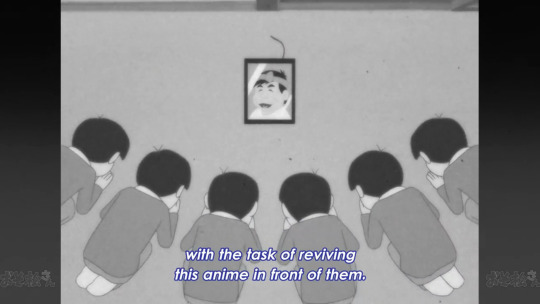
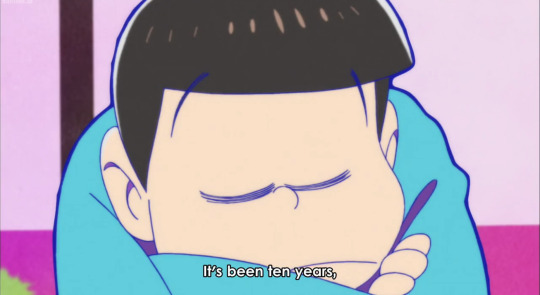
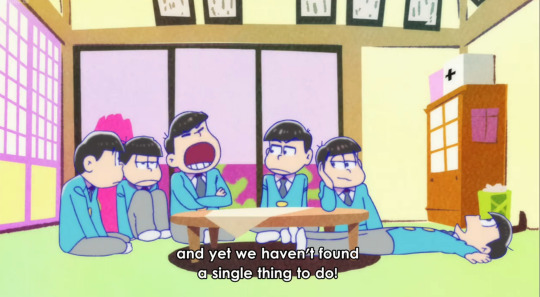
Right off the bat S1E1 makes it clear what to expect: Nothing. Not a damn thing. But, the show had already been cleared for this first season, so it has to be produced. This same episode’s preview is done by Osomatsu, which I’m just gonna quote instead screenshot because there’s too many.
“...we plan on properly starting the anime the next episode.” “...you ended up with an extra minute, so you need me to do something to fill it?! Actually, is this anime going to be okay with episode one being like this? I’m getting worried about how the rest of this is going to be...” “There, I used up a minute! [EPISODE ENDS]”
Episode one is not only batshit referential, but downright mocking the state of anime in 2015. Which, truthfully, I don’t have much to comment on in that regard, as I’m not an avid anime fan. However, it does this under the premise of being indecisive about what kind of anime they wanted the Osokun reboot to be.
They’ll do just about anything to stay popular and relevant considering that is, quite literally, all they have going for them as characters in the series and just being characters in general. They may be pieces of shit, but they’re likeable pieces of shit. The dynamics they’ve built upon to be entertaining is encouraged, and they’re basically just roleplaying different skits and fucking around.
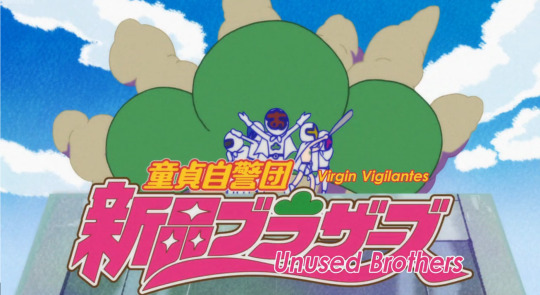
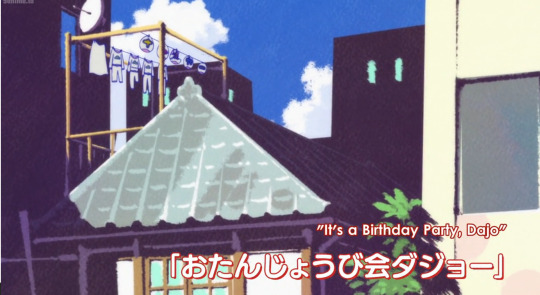
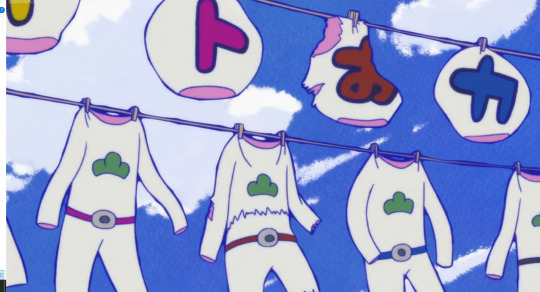
All the AUs! All the skits! They’re just playing! They’re just fuckin’ around!! They couldn’t come up with any interesting plot nor could they “graduate” from being anime protagonists and join the real world, so they just fuck around and make a gag anime!
Even if we follow both as the audience, the show makes a difference between the what’s them in their “normal life” (crazy begets crazy, no?) and what’s their “show.” But, really, that’s just one way to look at it, as they don’t really follow any rules as a show. I could say the Joshimatsus are separate characters from the sextuplets, and it’d be a “correct” interpretation. It doesn’t really matter - I’m choosing to examine it all as being the six of them just running around and playing, because being entertaining and having fun is all they know as characters. Besides, having it blended together beyond recognition reinforces how it prioritizes entertaining us, the audience, above logic. Storytelling doesn’t need to make absolute spatial-temporal sense for it to be enjoyable to fans.
In any case, that mentality really seems to be what pushes their character development negative, as they look to reinforce habits and rituals despite them being really detrimental for them in the long run. They know they’re popular characters as is, and with really everyone from staff to fans encouraging this behavior further, so they see no point in fixing what isn’t really broken.
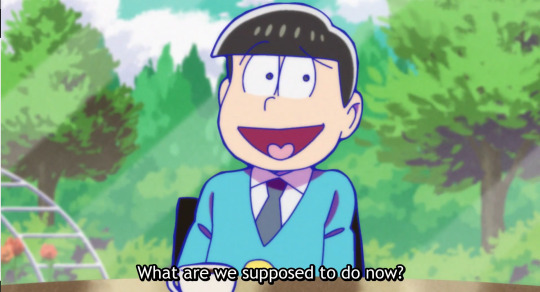

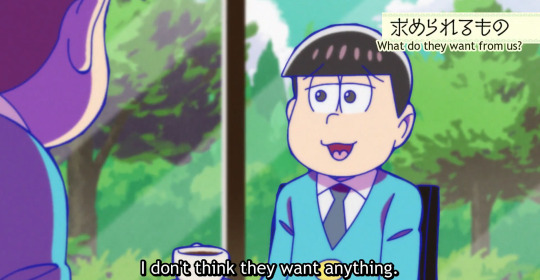
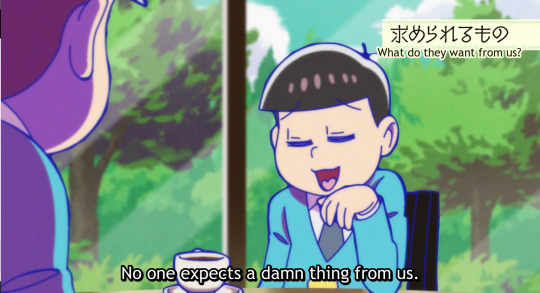
I found this 4 year old article from Manga.Tokyo discussing the Ososan phenomenon in Japan because while the craze died off pretty quickly in American anime circles (which deserves a whole other post), Japanese fans went fuckin’ nuts.
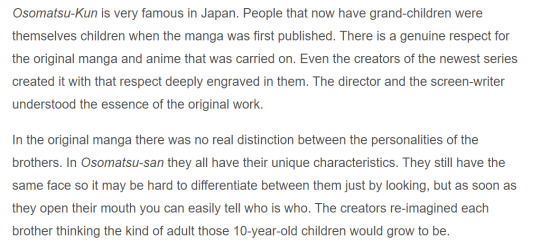
This portion caught my attention, as it makes sense that entitled and enabled asshole children would grow up to be entitled and enabled asshole adults. The article also goes on to compare them to idols (even beyond the F6 spoof) and that they are rooted in being comfort characters above all else.
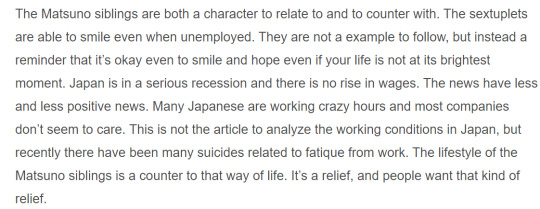
It’s worth a read, especially because Japanese fan response is what drives majority of the content post-S1, and, inevitably, ties into their character development.
They know that they’re Characters, particularly Protagonists. You know what happens to protagonists? Everything works out. Just about every single story created has stuff working out for protagonists. In fact, we have a whole genre made that separates stories with bad tragic endings from our Normal Stories. Ososan is a comedy, not a tragedy, so surely there’s gonna be some payoff somewhere along the road, especially as the seasons and other content are still being pumped out. To a self-aware, entitled, enabled protagonist, assuming everything is just gonna work out for you isn’t that far off from your narrative truth.
However, Ososan is a gag anime, and a lot of gag content (like 4koma mangas) is dropped for other projects before any emotional cathartic ending is provided for characters and fans alike. So, three seasons and a movie later, nothing has happened. It’s a great idol cash cow with a Family Guy filter, and the characters (and writers) don’t even bother to hide it anymore. And I know I’m being hypocritical concerning my definition of “canon material” but I think this portion from one of the drama cds “Choroplex” basically summarizes my point:
CHOROMATSU: Wait, don’t make this into a gag! You don’t even care about becoming employed, right? KARAMATSU: There’s no way that could happen... CHOROMATSU: What kind of future are you imagining? Is it nothing but this? [HUGE PAUSE BEFORE THEY MOVE ONTO SOMETHING ELSE]
They’re parodies of themselves and are running out of ideas. Stagnation and decay is normal, if not unavoidable, at this point in time for them. They’re just 20 somethings who’ve hit a wall but they’re too scared and insecure to bring about permanent positive change. It’s easier for them to fall back into normal patterns and joke off the rest.
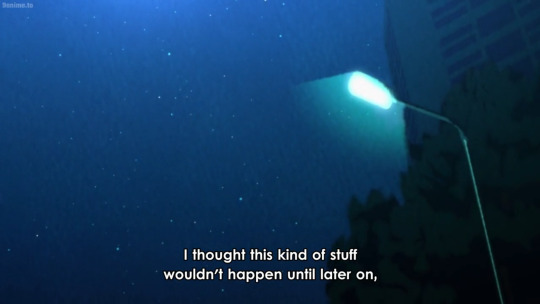
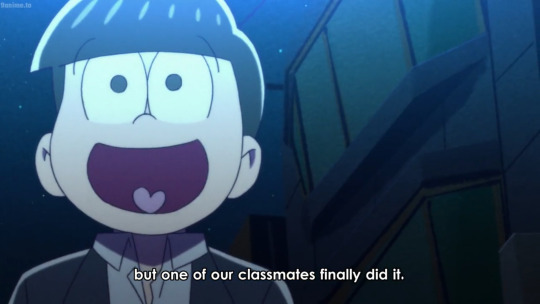
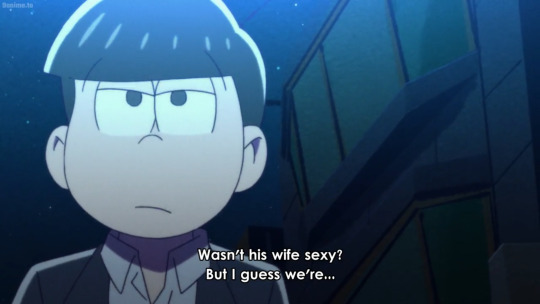
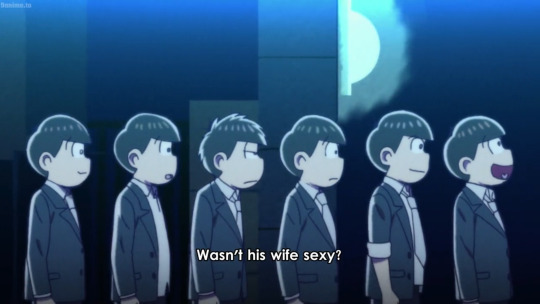
They have an antagonistic relationship with expectations. They can’t handle a single iota of expectations, or responsibilities. They’ve never needed to worry before, so why bother now? Once the biggest hits on the block, now they’re just guppies in the ocean, and there’s nothing they believe themselves to be able to accomplish to keep up with this big brave new world. This is epitomized in S3E15, where old man Osomatsu tells a bastardized version of the Tortoise and the Hare, blatantly projecting his feelings onto it. Again, too many screenshots so let me pull more quotes (bolding for my own reference):
“The place that the tortoise thought was the goal was not actually the goal. His journey down the road of life still continued on. The tortoise was quite tired, but he continued running anyway.” “No one actually knew who was in front anymore. There are too many people above you.” “After the tortoise found out how society worked, he thought, ‘So this is the difference in talent? No amount of hard work is going to fix this. All right. I’m done competing with others.��”
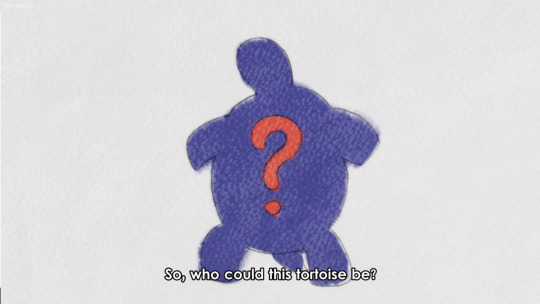
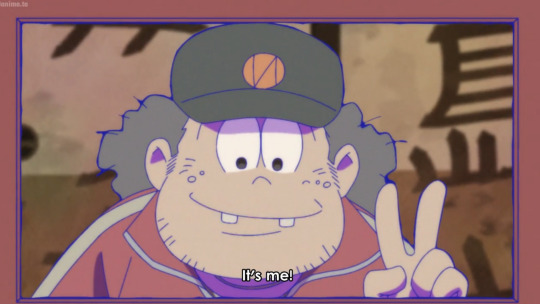
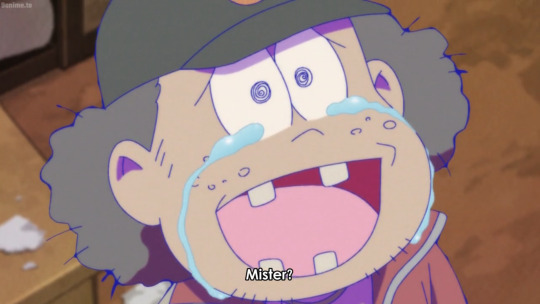
S3 has left more questionable endings than its counterparts. The last 2 skits I referenced don’t even a gag to them, and the marriage skit doesn’t play music for the entire second half of S3E5. There’s more involved too. I haven’t even brought up the rice ball twins becoming actual entertainers in their universe, or how they introduced this whole AI subplot only to reject it because All Six Of Them aren’t interested in expanding their little corner of the world. Here’s a transcript of the ending preview from S3E1:
“Hey, hey, Osomatsu here. I thought we were saved from being replaced, but I guess we get new characters next week. Man, we’re busy. New encounters, changing surroundings... We’re NEETs to begin with because all that is a pain. I guess a lot can happen after three seasons. [EPISODE ENDS]”
The sextuplets’ mindsets are extremely self-centered, which is also an environmental thing (the parents don’t even really care that they’re NEETs, for one) and an understanding of what they ought to be (epic successful protagonists). They also have a very black and white mentality, all or nothing. They’re extremely sheltered, and once they realized where they stood in society at large, they just gave up. To them the world is divided between winners and losers, and somehow, “inexplicably,” they found themselves to have fallen from grace. But they’re protagonists, that has to count for something! Everything’s gonna end up okay, right? Well... what this show has told them: No, not at all. They are consistently compared and warned of Iyami, and are perfectly aware of this fact, and have come to internalize it as a truth rather than a reversible self-fulfilling prophecy.
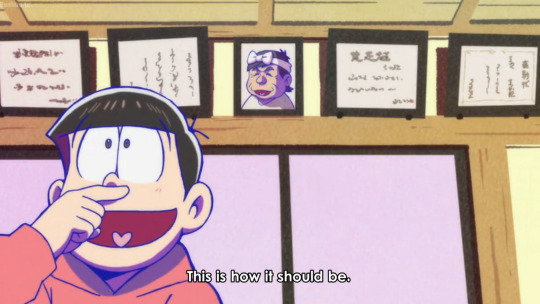
Too many screencaps, taken from the S3S5 marriage discussion:
JYUSHIMATSU: I wonder if we’re gonna get married someday, too. CHOROMATSU: Well, I mean... probably? I’m not exactly sure, but... TODOMATSU: What? You’re gonna get married, Choromatsu-niisan? CHOROMATSU: Huh? Well, yeah... someday.
Surprise! They have commitment issues! The same group that couldn’t commit to a fucking plot! Though their personality issues have several factors involved, I can’t overlook the theater motifs abound. Life’s a stage, and they’re performing entirely unscripted and it shows.
Do I think all of this is 100% intentional on the writers’ part? No, probably not. There’s also an extra layer here regarding contemporary Japanese commentary that I’m not familiar with, so I just ended up focusing on the characters. I can’t be in the writers’ heads, but whatever decisions are being made by executives regarding censorship and “compliance” are reflected in these character changes that result in being significantly more bitter and defeatist.
In the all or nothing, winner-take-all mentality, the only way to save face at this point, in their minds, is to own up to it - act like it’s what they wanted all along. And, hey, it’s funny to watch, right?
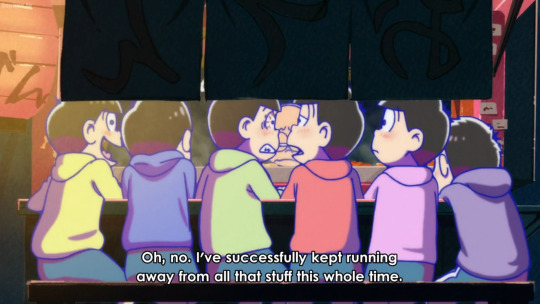
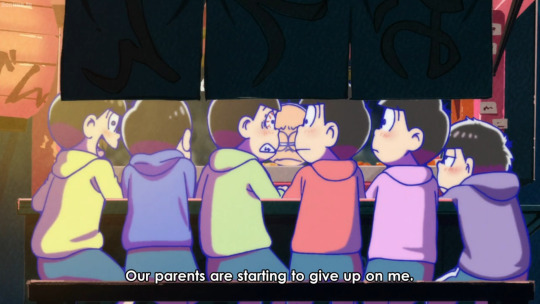
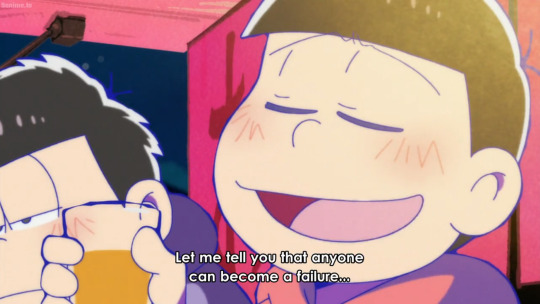
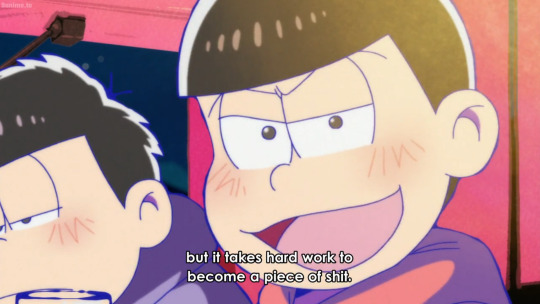
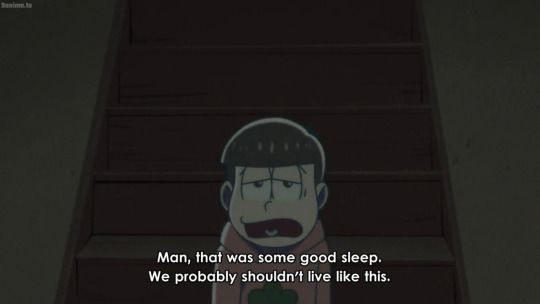
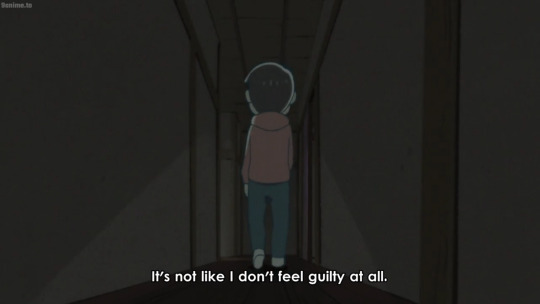
“Why is Osomatsu all my examples”, you might be asking. Well, he’s the damn blueprint for it all. The leader of the bunch, the first personality to grab your attention, has had all his issues projected and ricocheted in their echo chamber.
Ultimately, my point here is that you could think their “canon characterizations” (though canon means nothing in a show like this) as being intertwined with the nature of their self-aware existence. They’ve shown you all their tricks, the smoke and mirrors are getting boring, and they’re stalling long enough the story seems to be moving on without them - in spite of them. And when something genuinely threatens their way of life, they don’t know how to respond.
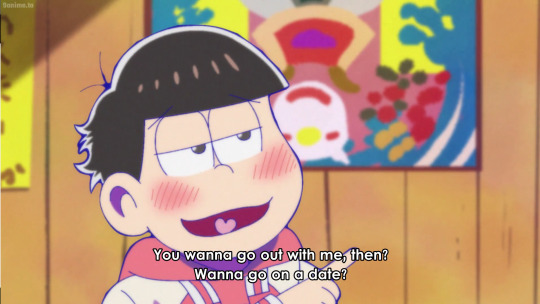
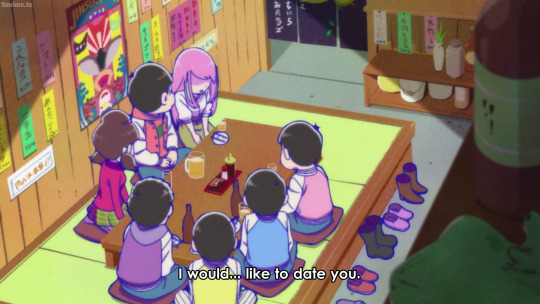
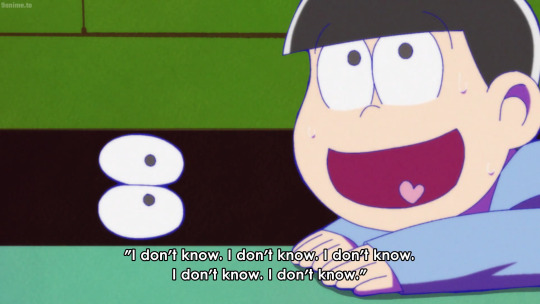
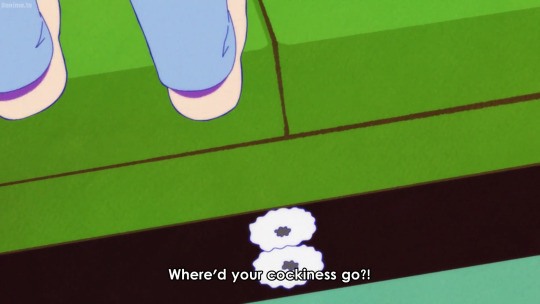
You can play it all straight, of course. Remove the meta jokes and all the same plot points can be hit, but, as a slapstick comedy, it’s able to easily add this additional layer in that I appreciate. I’ve said it in my last post and I’ll probably say it in more, but with comedy comes sincerity - the caveat of all the cartoon violence is that, on some level somewhere, this is how they really feel.
#osomatsu san#osomatsu#karamatsu#choromatsu#ichimatsu#jyushimatsu#todomatsu#osomatsu matsuno#karamatsu matsuno#choromatsu matsuno#ichimatsu matsuno#jyushimatsu matsuno#todomatsu matsuno#analysis#confession this was sparked by a convo i had w friends about s3e18#this is a bit truncated but i couldnt bring myself to make this longer#maybe ill make a pt2 or whatever idk
116 notes
·
View notes
Text
i also think it’s important to remember, for me, that i do draw a distinction between ‘mundane’ and ‘banal’. And its not just that I view them as interchangeable, or make it come off that way. A lot of stuff set in a mundane or real world context DOES feel banal to me: i have a great deal of trouble connecting to most characters in a real world-focused movie, for example.
But there is a distinction I draw.
Mundane, I think, applies to settings or situations obviously drawing from what we know now. This is not to say that it MEANS ‘real world’; for example, one of my favorite cases of this is the animated series Adventure Time, which is set in a magical, post-apocalyptic setting inhabited by strange and surreal creatures (with humanity itself being an isolated small group implied to be going extinct pretty quickly). Now, early on, there are episodes of the characters doing fairly mundane things, like watching a movie together! And I really love the combination of the fantastic in these very mundane situations.
Banal, conversely, is when you take the every day and make it the whole focus, and it’s honestly really boring to me. Most romance stuff, slice of life or the everyday fits in here, and it’s just... it’s dreary to me.
2 notes
·
View notes
Text
Final Fantasy II review
One of the most interesting parts of the Final Fantasy series, and a big reason why I’m so fond of it, is that every main series game takes its own approach to the gameplay. From the job systems of III and V, the Materia system of VII, the Junctioning system of VIII, or the straight up action combat of XV, every game has a different focus that makes them stand out, and while the results can certainly fall short at times, it’s still something worth commending. For example, take the subject of today’s review, Final Fantasy II. For the second game in the series, and a game that came out in 1988, it’s a huge step up from the original game in a lot of ways. A much more detailed plot, containing several defined playable and supporting characters, a much more experimental battle system, the introduction of many elements, gameplay and otherwise, that would establish a true identity for the series, away from just being a ripoff of Dungeons & Dragons 1st edition, it’s an impressive and critical step forward for the series. Unfortunately for the game, it hasn’t been 1988 in over 30 years, and it’s now easily the weakest game in the series in my opinion. As for why that is, well, that’s what we’re taking a look at today. As with the first game, I’m reviewing the PSP version. Note I’ll be pretty lax with spoilers, so take caution, if you actually care to avoid spoilers.
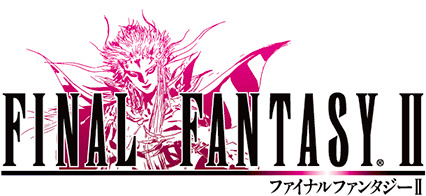
Story: Final Fantasy II takes place in an entirely different world than Final Fantasy I, a tradition that every main series game would follow. The peace of this world is shattered after the rise of Emperor Mateus of Palamecia, who, bent on world domination, raises a fearsome army and unleashes the denizens of Hell upon the land, conquering a large portion of the world. The city of Fynn organizes a large resistance effort, only to be attacked by the Emperor’s army, forcing a small remnant to flee to the town of Altair, establishing the Wild Rose Rebellion, led by Princess Hilda. During the fall of Fynn, four youths, Firion, Maria, Guy, and Leon, attempted to escape as well, only to be attacked and left for dead by the Emperor’s soldiers, with Leon going missing as well. Rescued by the rebellion, and healed by the white wizard Minwu, Firion, Maria, and Guy, having nothing left to return to, and wishing to search for the missing Leon, join the rebellion to fight back against Palamecia. Meanwhile, the Emperor, his army having taken heavy losses taking Fynn, takes to devising much less conventional methods of establishing his rule, starting with a massive airship called the Dreadnought, meant to scare the populace into obedience, on threat of total destruction.
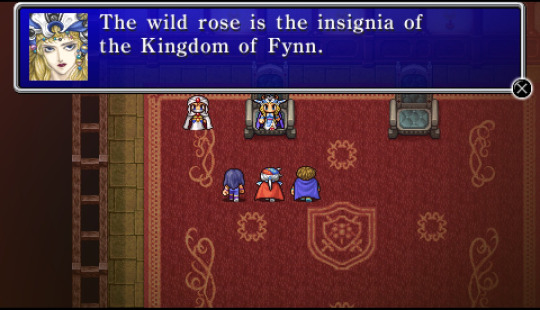
Compared to the very light plot of Final Fantasy I, the story here is much more involved. Instead of wandering between locations more or less aimlessly, there’s always an explicit plot reason to go to new locations, the party being given tasks like finding mythril to supply the rebellion with better equipment, or trying to recruit potential allies. Compared to the party in the first game just being completely blank slates, the party consists of the more distinctive Firion, Maria, and Guy, with the fourth slot being filled by various guest characters that come and go as the story goes on, such as Gordon, the prince of the fallen kingdom of Kashuan, and Ricard Highwind, the last of the dragoons, and there’s actually an established side cast, including characters like Hilda, the leader of the rebellion and princess of Fynn, Paul, a noble thief assisting the rebellion, and Cid, a former knight who maintains the world’s only airship, with this notably being Cid’s first appearance in the series.
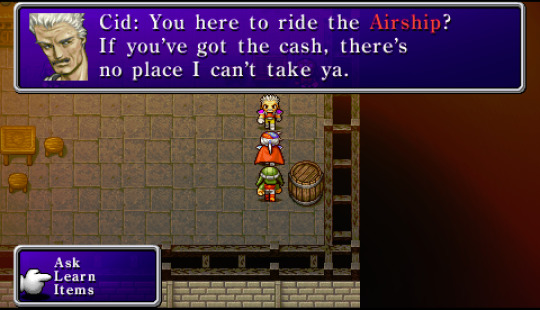
Final Fantasy II is also very noticeably darker than the first game. While the plot circumstances of the first game weren’t exactly cheerful, with the world falling apart due to the influence of the Fiends, outside of a select few towns, this wasn’t very obvious, and the game overall carried a bright, adventurous feel. Not so with Final Fantasy II, where the Emperor is a much more prominent and ruthless villain who’s already conquered or ruined a majority of the world, always keeping another plan on standby, and staying one step ahead of the heroes. Many characters die over the story, from random NPCs to even temporary party members, and the game overall carries a prominent melancholic, empty feel to it, one that’s very impressive considering the time it was made.
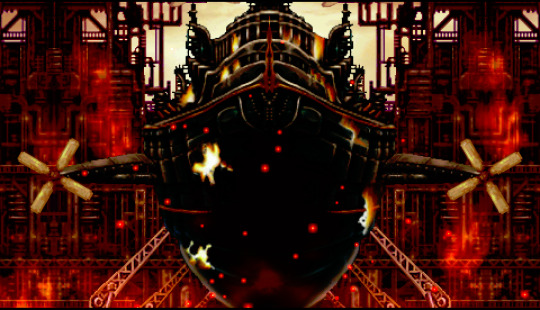
To be honest, however, it actually goes a bit too far in this regard. Almost everything the protagonists accomplish comes at the cost of allies dying, or something preventing them from fully completing their mission. Many NPCs are pessimistic about the chances of humanity being able to win against the Emperor, and so much destruction is wrought upon the world by the end that it seems there’s not even much left to save. From the very beginning of the game, which starts with your party instantly being destroyed in an unwinnable battle, the game is nothing but a constant stream of death and hollow victories, with plenty of characters you can find mourning their losses, and there’s very, very few points in the story that offer any sort of relief from it. Combined with the Emperor barely seeming bothered by anything the party accomplishes, and running circles around them more than a few times, it’s very easy to simply lose any investment in the story.

The characters unfortunately only add to this lack of investment. It’s hard to hold it against the game, but the main party of Firion, Maria, and Guy is still easily the least developed cast in the series. They have little dialogue to themselves to begin with, and have very minimal personality traits, especially Firion, who pretty much only exists to be the hero by default. Additionally, whereas in most RPGs, the cast’s varying personalities and skills tend to gain importance, here, the only skill any of them have is Guy being able to talk to beavers, which only comes up once in a way that doesn’t even affect the story, and, again, they have nearly no personality otherwise, which totals out to each of them having, at best, 1 moment each throughout the story where they’re not completely interchangeable with each other, which barely elevates them above the completely blank slate party of FF1.

The guest party members and NPCs fair a bit better, but not by much. The guests tend to be at least mildly interesting, like the fatalistic Minwu, the cowardly Gordon, who learns to be courageous as the story goes on, to the pirate girl Leila, but they’re still nothing special, and there’s surprisingly few other NPCs, most of which aren’t too memorable either. Even the Emperor himself is about one of the most stereotypical evil emperor characters you could have, not helped by the very few scenes he gets. That’s not to say he’s a bad villain, though. His successfulness does create a presence that looms over the entire story, and he pulls off one of the coolest plot twists in the series; after being killed by the party in a very easy battle late in the game, he simply returns as a demon himself, having become far, far stronger than he had ever been in life, to the point of taking over Hell itself. It’s such a unique and unexpected twist on the seemingly weak political villain that it alone cements the Emperor as one of the more memorable villains in the series. Overall, while the writing of the game is quite impressive for the time, and laid a good deal of groundwork for the improved writing of future entries, it’s just passable at best nowadays.
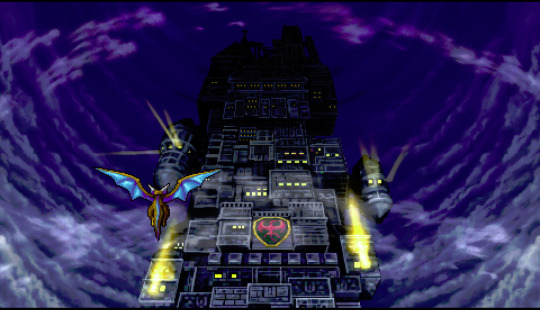
Gameplay: Here’s where things really start falling apart. On the surface, not much the combat doesn’t seem terribly different from Final Fantasy I, with it still being a standard turn based system with basic commands like attacking, using magic, and defending. The big differences in Final Fantasy II’s combat lie in the character progression. The first game had you simply selecting a party of 4 classes at the start of the game, gradually making them stronger across the game by leveling them up and acquiring specific equipment and spells for each, like pretty much every normal JRPG. FF2, on the other hand, uses a much more complex system. Every party member is capable of using every weapon and learning every spell, in the process abandoning the D&D system of set spell charges and instead introducing the traditional MP system, and characters are not set in specialized classes and roles. Instead, FF2 discards the usual EXP based leveling system, and instead uses a stat leveling system, where the individual stats of each character level up separately depending on the course of battle, and while each character starts with predetermined stats that favor a particular role for them, with enough grinding, you can still reshape them however you wish. This stat growth system would later be used and refined for the SaGa series, and it’s a very ambitious attempt at improving upon the party building system the first game established.
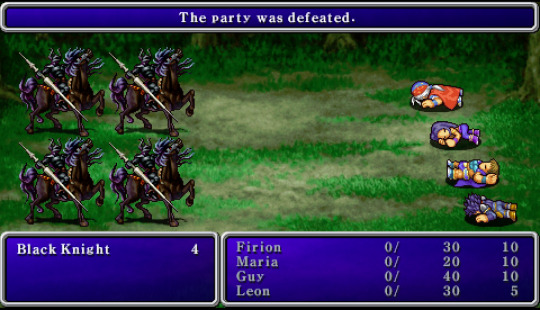
In total, there are 12 main stats that can be increased through battle: HP, your health points, which is raised in regular intervals, or losing HP in battle, MP, magic points that allow you to use spells, which is raised by having MP reduced in battle, Strength, which determines your physical attack, and is raised by using the attack command, Magic, which determines how much MP you get when it is gained, and is raised by having MP reduced in battle, Spirit, which determines the strength of white magic spells, and is raised by casting white magic in battle, Intelligence, which determines the strength of black magic spells, and is raised casting black magic in battle, Stamina, which determines how much HP you get when it is gained, and is increased by losing HP in battle, Evasion, which determines how likely a character can dodge physical attacks, and is raised by being targeted by attacks in battle, Agility, which factors into evasion calculation, and is raised by having high evasion, and Magic Defense, which determines how resilient a character is to offensive magic, and is raised by being targeted by offensive magic in battle.
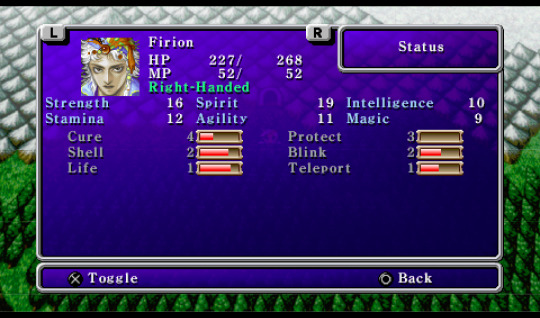
However, it doesn’t stop there, as individual weapon types and spells also have levels that can be raised, which is done so by gaining skill points in them by attacking or casting them during battle. Once enough skill points are gained, they advance to the next level, with the hard cap being 16. Gaining weapon levels allows that character to be more accurate and attack more times at once with that type of weapon, and raising spell levels increases their power and makes them more accurate. Each weapon type, consisting of swords, spears, axes, staves, knives, bows, shields, and unarmed, have different attributes, such as spears being a relatively balanced type, with lower individual power than swords and axes, but higher accuracy, while bows are allow characters to attack from the newly introduced back row, which makes them immune to physical attacks, but prevents them from attacking with any other weapon type. While focusing on one weapon type with each character would seem the most efficient, the game only tends to give you one or two weapons of each type at a time, many of which have good boosts in power or added effects, making focusing on a few different types a decent idea.
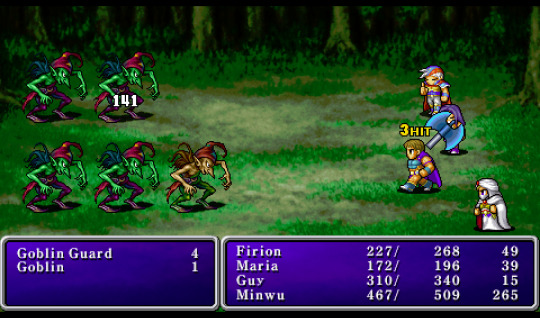
Shields are unique in that, while equipping them doesn’t raise your defense as might be expected, and actually lower your attack, they give large evasion bonuses that makes dodging attacks much easier, and have the chance of blocking a physical attack completely even if something does connect, all of which increases as you gain levels in it. As for other defensive equipment, you have heavy and light types of armor, with light armor giving less defense bonuses than their heavier counterparts, but not weighing nearly as much, and thus leaving you much more evade. As for spells, they start out very underpowered, and have awful accuracy in the case of buff and debuff spells, but become much more effective after a few levels, with the downside of them costing more MP to cast with each level gained. Characters can learn up to 16 spells, and are free to remove them at any time, at the cost of having to level them again from scratch if they ever relearn them. Instead of simply learn spells by buying them in towns, spells are instead learned from tomes, which can be bought from shops, found in treasure chests, or dropped from enemies. Using them on the field teaches a character that spell, while using the tomes in battle instead casts a high level version of the spell, at the cost of losing that tome.
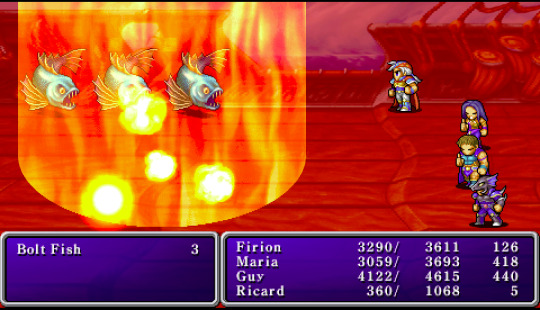
Unfortunately, as creative as this all is, this system has some serious issues. The main one, which you have already guessed, is that the game is incredibly, incredibly grindy because of these mechanics, and in a much worse way than most other RPGs. While not every stat is going to be important for each character, depending on how you build them, there’s still a lot of things it forces you to keep track of. Even if you want to make a dedicated mage, sticking in the back row with a bow for the whole game will leave them with so little vitality and HP that they’ll just be uncomfortably fragile, and with the magic attacks enemies have by the endgame, you really want to keep them in the front row for a good part of the game. Most spells, including important ones like Life and Esuna, for reviving party members and removing status effects respectively, while extremely useful, have such horrible accuracy to start that they’re completely useless before you level them up, and the weapon distribution is quite unbalanced, with swords having easily the best selection even in the midgame, essentially leaving most other types as stopgaps.
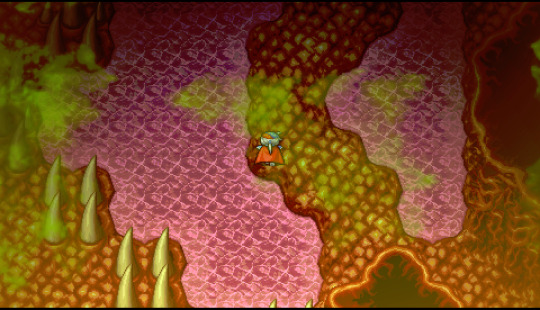
While you might level your important stats a good bit just naturally going through areas, trying to deliberately level any of them is a commitment. While HP, strength, spirit, intelligence, and magic defense tend to come easily enough, increasing stamina often only happens through the loss of a large chunk of their maximum HP, which, obviously, preferably doesn’t happen on a regular basis. This goes likewise for MP and magic, which is rather irritating, as not only do you need more and more MP as your spells level up, but ways to restore MP are extremely limited and costly. The bizarre loop of agility factoring in to evasion increasing, while itself only leveling up based on your current evasion, means that the only reliable way of increasing either is to equip the lightest equipment you have. While leveling up weapon levels is easy enough, especially since you can dual wield different types at once, leveling up spells is a much slower process, with casting low level spells during random encounters, even those that won’t actually help at the moment, often being one of the only feasible ways to get them leveled quick. You may even be tempted to ignore magic beyond simple spells like Cure because of the individual effort needed, but the game will quickly hammer the importance of magic into you; from the randomly encountered flans and bombs that either have absurd physical defense or tend to explode if not fully defeated in one turn, with magic being the only reasonable way to take them out, to mandatory bosses that hit quite hard, and also have enough physical defense to make physical attacks nearly worthless without absurd grinding, you’re not getting through the early game without dedicating some time to magic. On the flip side, another early dungeon has a boss that outright absorbs magic, making physical attacks the only way to beat it.
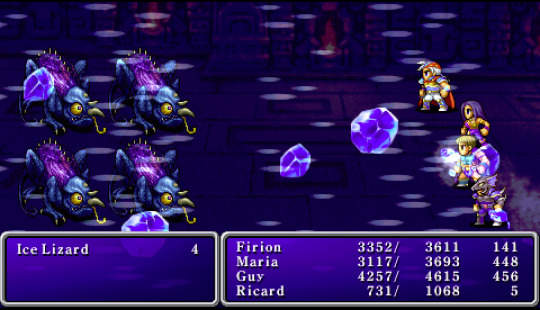
The game has quite a reputation for being brutal, and it’s not inaccurate, with most dungeons being more than glad to beat you down without remorse, and there’s tons of troublesome enemies to be found throughout the game, doubly so if you try to go for all the treasure chests in the area, as many of them are guarded by encounters called monster-in-a-box, which are often much more powerful than other encounters around. Most bosses are more than happy to make your life miserable too, especially the infamous Lamia Queen and Behemoth. However, this difficulty is in no way fair or well designed. While the growth system can easily leave you unsure as to whether or not you’re prepared for a dungeon, since you have no easy guideline to go off of compared to standard leveling, that’s not even the worst of it. The design of the dungeons, and even the world map, are horrible. There’s tons of doors scattered throughout pretty much every dungeon, and 90% of them lead to dead end rooms with raised encounter rates. There is absolutely no way to tell which doors are dead ends and which are necessary to progress, so you’re reduced to trial and error, which is extremely exhausting when there’s so many doors per dungeon, and you’re almost guaranteed to get into an encounter before you can leave each one, and if you’re tempted to ignore any doors when they don’t seem mandatory to progress, in many of those cases, there’s treasure rooms hidden among them, once again with no way to figure out other than guessing.
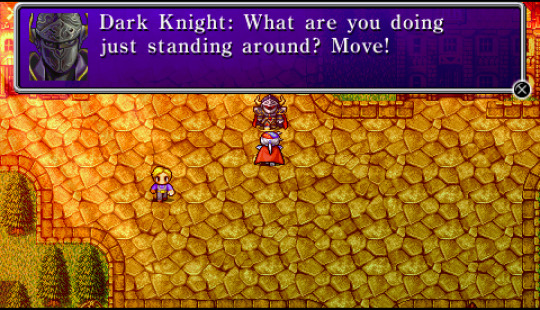
The world map, on the other hand, is one of the best arguments against open ended world design there is. Compared to the first game, there are almost no physical obstacles barring where you can go, other than a few rivers that are only crossable by canoe, something you get almost immediately, and a few areas only accessible by boat. Instead, you’re kept out of where you’re not supposed to be through the Dragon Quest 1 method of having the random encounters kill you horribly. The problems with this method are twofold: not only are the borders between where you’re supposed to be and where you’re not very thin, to the point of running into late game enemies just outside of the first town if you go just a biiit too far to the left, compared to Dragon Quest 1 often using bridges as visible borders between areas, but it just doesn’t really fit with how the game is designed. Dragon Quest 1′s pacing is rather relaxed, as while you do have plot objectives, the game doesn’t rush you to fulfill them. You’re meant to just hang around the areas you can survive in, grinding your way up and getting whatever equipment you need until you feel confident to move onto whichever area seems to be designed for next. In Final Fantasy II, you’re constantly being sent back and forth between areas to get new orders or do whatever the plot wants of you at that moment, but while the game loves telling where to go, it’s pretty bad at telling you how to get there, with its often vague directions being spread out between NPCs in multiple towns, to boot. While there is a map of the overworld you can access, it can still get pretty annoying having to meticulously check where you’re going, and you’re still liable to being decimated just because you wandered into a harmless seeming area. One nasty example comes after completing Kashuon Keep, not too far into the game. You’re expected to head back to Altair, which is on the other side of the world and is quite a bit of a walk, but heading south soon loops back to the Altair area, making for a much shorter walk. Trying to put this idea into practice, however, sends you across the large Palamecian desert, full of enemies more than eager to tell you that this area is still a few dungeons away from being accessed. It’s not completely unsurvivable, and can be safely traversed by finding the nearby hidden Chocobo, but it’s still a nasty situation after a very irritating dungeon.
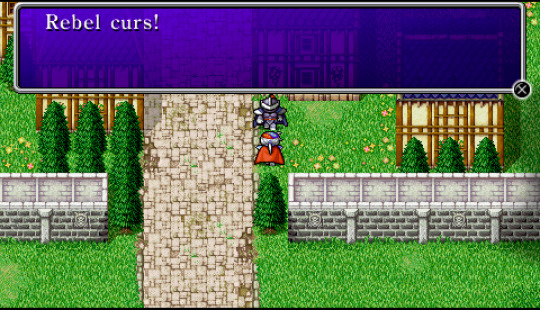
The biggest, and most frustrating, source of difficulty, however, is that the game stubbornly refuses to tell you anything about what’s going on behind the scenes. There’s so many mechanics left unexplained that cause a lot of difficulty if you don’t understand them. For example, every enemy has a stat called rank, which determines how many skill points for your weapons and magic you’ll actually get by using them on said foes. Essentially, if your weapon or magic levels are higher than the enemy’s rank, you need to use that weapon or spell more times in that battle based on the difference between the numbers to actually get any skill points. Not an unreasonable system, and you can view every enemy’s rank in the bestiary, but the game never directly addresses this, and even the most powerful enemies only go up to rank 10, effectively softcapping your skills and spells at 10, which often leads into having your party attack each other to bypass the entire mechanic, a depressingly efficient solution most of the time. Other stats the game never cares to explain are evasion and magic defense, which both display both numbers and percentages. For evasion, the number represents the number of attacks that character is capable of dodging, as physical attacks strike multiple times per round, and the likeliness of evading each attack. With magic defense, the number represents the number of attempts at avoiding a status effect can be made, and the percentage represents the chance of successfully doing so. Despite the name, the stat does not reduce damage taken from magic attacks.
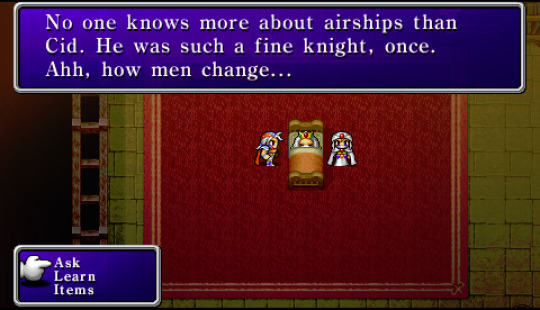
On the subject of magic, the spells available to you are also plagued with unneeded complexity and vagueness. First off, the descriptions for many spells tend to only give you the barest idea of what they actually do; Aura “Enhances effectiveness against various foes.” It never tells you what enemy types count, or that it only becomes effective against certain types as its level increases, you just have to hope that it’s working whenever you use it. Barrier “Raises a barrier to defend against special attacks.”, again giving you no indication as to what it’s actually protecting against. Shell and Wall both claim to raise magic defense, but give no obvious indication how they’re actually different from each other, and Dispel claims to remove protective magical barriers, which lowers the target’s magic defense, even though you may infer that it removes buffs, like in later games. Other spells tend to be redundant or very situational. Basuna removes temporary status effects, compared to Esuna removing permanent status effects, which is near worthless since not only do temporary effects wear off after a number of turns, but they go away after battle regardless, and are rarely effective enough to waste a turn removing. Fear increases the likelyhood of enemies fleeing battle, which is not only rare to actually work, but is worthless, since you don’t get any credit for defeating any enemies that do flee. Sap reduces the MP of the target, which is not only rarely likely to work, but counterintuitive if you have the infamous Osmose spell, which saps large amounts of MP while restoring the same amount for the user. Status effects also have different elements to them, namely body, mind, and matter, with most enemies having different resistances. Some spells, like Stop and Paralysis, have the same effect, but different elements, and keeping track is both difficult, both remembering which spell is which element, and what enemies are actually affected by each element, and nearly pointless, since the effects are rarely worth bothering with in favor of just attacking. Matter elemental spells, however, are rarely resisted by most enemies, even bosses, and mostly comprise of instant death spells like Mini, Break, Teleport, and most infamously, Toad. Not only does this game make instant death spells effective, it makes them downright overpowered, with almost every encounter being capable of being solved through judicious application of Toad.
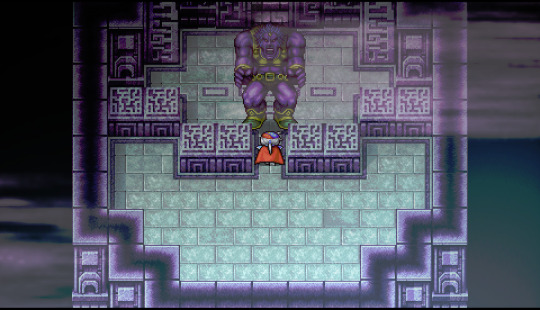
But the peak of all this is a special property that some enemies, like ghosts and the final boss, have applied to their physical attacks: a draining effect that not only restores their HP by the amount of damage inflicted, but specifically inflicts 1/16th of the target’s maximum HP per hit, with them eventually attacking 8 times per turn by the final dungeon. To sum this up simply, this makes heavier equipment worse than worthless. Not only will the defensive power do nothing to protect from this damage, but it actively weighs you down and destroys your evasion, guaranteeing you’ll take all those possible hits unless your did some extreme evasion grinding. You’d be protected better by not wearing anything at all, because at least then you’ll make use of all your natural evasion. Unless you want to constantly heal your characters for half their health everytime you run into specific encounters, you have to dedicate a lot of your time, or most of your run through the game, to getting their evasion leveled enough that this isn’t a problem. Knowing this can be the difference between fruitlessly blowing all your resources and breezing through effortlessly, and there is a certain weapon, the Blood Sword, that has this same draining effect, which can singlehandedly annihilate the final boss once you’ve figured this out. While there’s a few other smaller issues, like several encounter formations that cannot be ran from for no apparent reason, other than possibly being formations used in certain monster-in-a-box encounters, those are the main issues, and being aware of them, and having the information to circumvent them, makes the game much, much easier. If anything, it makes the game extremely breakable. From physical attackers that dodge everything thrown at them, to spellcasters that can wipe out encounters with a single cast, it doesn’t take much to erase the difficulty once you know what you’re doing.
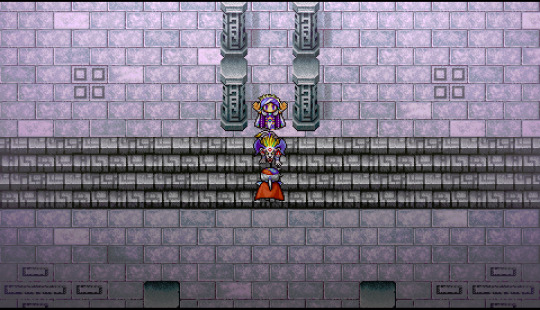
As for bonus content, there’s Soul of Rebirth, a bonus mode unlocked after completing the main game, first added in the GBA version, which focuses on several characters who die in the course of the story finding themselves in what they think is the Jade Passage, the path to Hell. While a cool concept that has a really neat final boss of its own, namely the light side of the Emperor, who split off from his dark half after death and instead took over Heaven, it still has issues of its own, namely that most of the party are guest characters in the main game, and carry over the stats, equipment, and spells they had when they left the party, meaning if you didn’t bother training them and stripped them of all equipment before they departed, you’re in an absurd time. The mode is also quite short, and only consists of two dungeons that are just mirrored versions of the final two dungeons of the main game and a town. A neat addition, but not much more than that. Other than that, the only optional content to find in the main game is the Arcane Labyrinth, a bonus dungeon added specifically for the PSP release. The game uses a keyword system where you can learn important terms from NPCs, and ask about those terms to get directions or a bit more plot. It’s sort of neat in concept, but in practice it doesn’t amount to much other than make it slightly more annoying to find out what to do, especially if you manage to miss a keyword. The Arcane Labyrinth, however, revolves around its use. In order to progress past the entrance, you must select a keyword at the portal to the next floor, which then takes you to a specific floor based around the keyword you chose. Almost every floor has a little sidequest to solve, like defeating specific enemies or giving items to NPCs, which give you new keywords exclusive to the labyrinth, or hints for some of the trickier floors. While they can be kinda annoying to do, you only ever have to complete them once for their reward, and can otherwise run straight to the exit on subsequent visits.
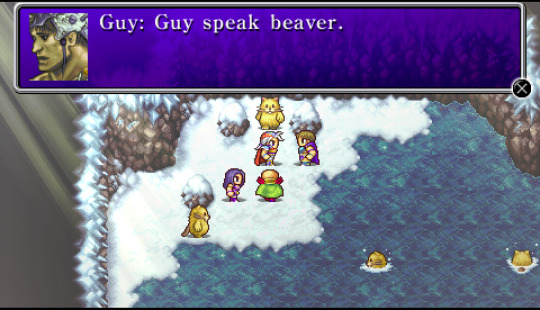
Every floor requires you to select keywords for the next, with 45 different floors being available in total, and the Arcane Labyrinth is actually split into 3 sections, with the northwest section requiring four floors to be visited, the northeast seven floors, and the south ten floors, though while you can’t visit the same floor twice in the same section, you can choose repeats in separate sections. There is much more strategy than simply randomly selecting floors, however. Each keyword belongs to a different category, which cause different reactions depending on your next choice. Picking keywords in the same category in a row cause better treasure to spawn and lower the encounter rate, while picking something in a category that opposes it, such as a matter and materials floor after going through a magic and spirits floor, has the opposite effect. Even more importantly, each playable character has a set of keywords that resonate with them, to varying degrees. This becomes important after finishing all three sections, which unlocks the Arcane Sanctuary. Within is Deumion, the master of the Labyrinth, who summons a superboss, Phrekyos, to test you, with its strength varying depending on how many keywords you’ve gotten through the story, making it beatable even in earlier parts of the game. Beating Phrekyos allows you to get a reward from Deumion; if you picked enough keywords that resonate with a certain party member, you will be able to get their ultimate weapon, which not only have tons of power, but confer massive stat boosts when equipped. If your keywords didn’t resonate enough, you only get an elixir, something that you can buy, albeit with absurd amounts of money. The optimal keywords for the main party are only unlocked in the endgame, but it can actually be worth visiting early for the party members that are used in Soul of Rebirth, as the weapons make it much more manageable, though visiting too early can end with you being much too powerful compared to how you should be. A special set of keywords also allow you to see Deumion’s past, leaving you able to either peacefully receive from him the Revive spell, or fight him as the ultimate superboss for the Destroy spell. Both are disgustingly impractical, but it’s a neat idea nonetheless. Overall, the Arcane Labyrinth, though still rife with its own set of frustrations, is actually one of the more enjoyable bonus dungeons I’ve come across, with a very creative concept that actually leaves you curious as to what the next floor could hold.
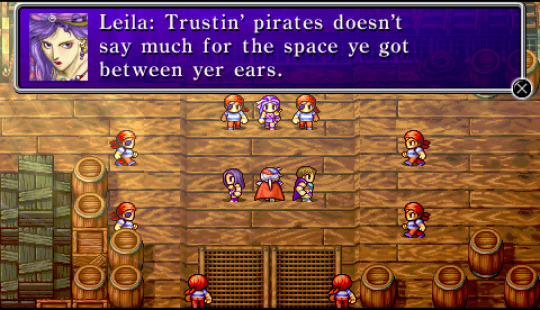
Overall, while the gameplay of Final Fantasy II has some interesting ideas, it’s held back by an irritating lack of explanation as to how it works, the overly grindy design, and just plain poor design and execution. It’s a miserable experience that makes even other early JRPGs seem appealing, just because their grinding is so much simpler to handle, and I need to note, this is the most polished version of the game. Between bugs, a horribly limited inventory, and even more absurd design decisions, like stats sometimes decreasing instead of increasing, or weapons massively decreasing magic accuracy, and increasing skills taking even longer, any version earlier than the GBA version is even more infuriating and even less playable.
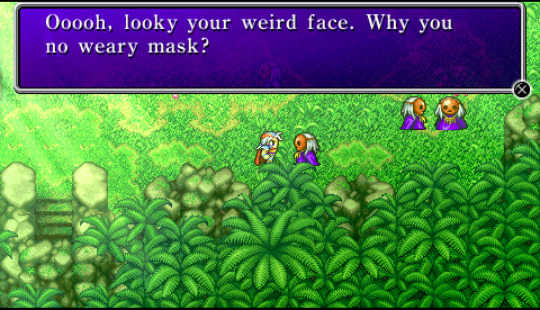
Graphics: Final Fantasy II is actually a quite nice looking game, as with the rest of the Final Fantasy releases on PSP. Locations have a lot of detail to them, like ambient effects like rolling fog, and noticeable lighting effects, with a few areas like Pandemonium having pretty fascinating designs, and there’s some pretty good looking cutscenes for bigger story events. Spell animations are pretty neat, and attack spells have a nice detail where their animations become more elaborate as you level them up more. Characters even finally look accurate to their original art by Yoshitaka Amano, unlike earlier versions, though that’s not necessarily a positive: between Firion’s random mishmash of materials and colors, Maria and Guy’s awkward, half complete outfits, and the terrifyingly gaudy Emperor, this is possibly the tackiest looking cast in the series. The monster designs, on the other hand, are top notch. After Final Fantasy I’s bestiary was lifted almost entirely out of D&D, this game introduced a lot of original and iconic enemies, like the coeurls, the bombs, the malboros, the adamantoises, and the behemoths. It even introduced chocobos, though it’s easy to miss their existence, as their confined to one spot on the world map that’s decently hidden. While there are still a lot of oddities like vampires and giant mantises, it’s still one of the biggest advancements in the series in this regard. The enemy designs also excel in that they look much more threatening than in the first game. These enemies literally come from Hell, and look the part. I’d even go so far as to say that this is the best looking Final Fantasy game on the PSP, and has some of the coolest enemy designs in the series.
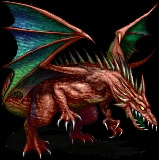
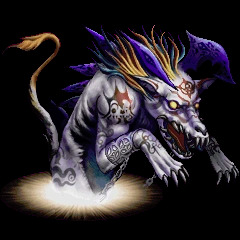
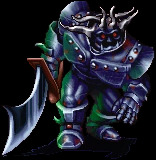
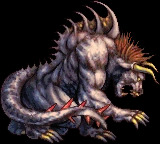
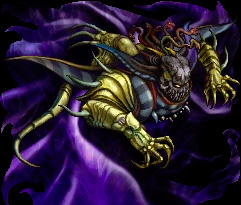
Sound: Final Fantasy II’s soundtrack was composed by Nobuo Uematsu, as usual, and remixed by Tsuyoshi Sekito for the remakes. All things considered, it’s my least favorite soundtrack in the main series. That’s not to say it’s bad at all, and there are some great tracks like the Rebel Army Theme, the somber main theme which plains on the overworld, Ancient Castle, the Tower of the Magi, Battle Theme A, typically used for major boss encounters, and Battle Theme 2, the final boss theme. However, as an overall, it’s just not quite as good as the soundtracks for the rest of the main series, to me. It also contains my least favorite version of the Prelude, being just a bit too high pitched for my liking, and my least favorite battle theme, sounding way too intense just for regular encounters, and quickly becoming grating not too far into the game. The soundtrack is good in its own right, and is worth a listen, it just doesn’t quite reach the heights that some of the others do.
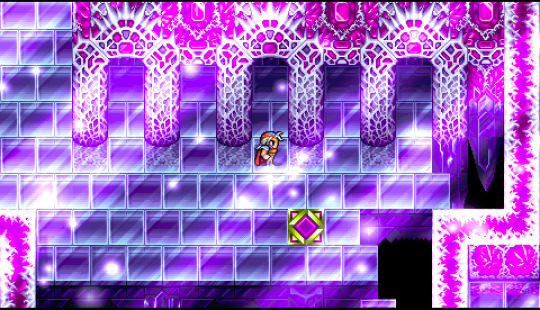
Conclusion: Overall, I give Final Fantasy II a firm not recommended. Though very ambitious and important for its day, its story, design, and mechanics have aged like milk compared to the other Final Fantasy games on the NES. While technically still perfectly playable, especially with deeper knowledge as to how the mechanics work, it doesn’t make for much fun at all. You’re better off keeping your distance from this entry. Now, with this absurdly long review finally done, finishing this game, and the subject of my next review, hopefully to be soon, have convinced me I need a break from older RPGs for a while. Till next time. -Scout
6 notes
·
View notes
Note
Alright, I've been wondering about this for ages, ever since you first started talking about Love & Labyrinths stuff. HOW does a dating sim work in the medium of a TTRPG? I assume it must be meaningfully distinct in some way from "the players can date each other's characters" or "there's the possibility of a PC/NPC romance if the GM is open to it."
(With reference to this post here.)
I suspect some confusion might arise from the fact that the term “dating sim” is used interchangeably to refer to two completely different genres of video games: a. visual novels where you can go on dates, and b. life sims where you play out the protagonist’s life on a formal schedule or calendar, balancing your expenditure of time and other resources against a variety of competing priorities, including pursuing relationships, earning money, and marking incremental progress toward various narrative goals. It’s the latter type that we’re concerned with here.
That sort of “dating sim” isn’t something you see much from Western developers, at least outside the indie sphere, so most of the good examples you may have heard of are going to be localised Japanese titles. The Persona series -- at least from Persona 3 onward -- would probably be the most familiar to general audiences; it’s not a pure example of the type, mixing its life sim elements with roguelite dungeon crawling, which conveniently makes it a pretty solid example of what Love & Labyrinths is shooting for!
As for how this sort of thing can be implemented at the tabletop, there are a variety of existing games you could look to for examples:
Hayley Gordon and Vee Hendro’s Good Society applies a life-sim framework to the novels of Jane Austen, while their forthcoming Fight With Spirit tackles sports anime in a similar fashion. (And you should absolutely sign up for the latter’s playtest if you feel you’d be able to contribute!)
Jenna Moran’s Chuubo’s Marvelous Wish-Granting Engine takes a more meta approach, presenting a system where relationships are skills and emotional beats are worth XP in a game about adolescent gods growing up in a pastoral small town. Fair warning: this is not a game for casual pick-up-and-play -- the learning curve is very steep if you’re not already well versed in diceless roleplaying.
Somewhat perversely, Blades in the Dark is also a good point of reference; it has absolutely nothing to do with dating (it’s about running a brutal criminal empire in a dystopian ghostpunk city where the sun never rises), but its rules are a kind of life sim all the same, treating reputation and emotional stress as currencies for an elaborate downtime system that plays out what your crew gets up to between heists.
Does that answer your question?
#gaming#tabletop roleplaying#tabletop rpgs#love & labyrinths#lnl#game design#penguin king games#iodhadh
199 notes
·
View notes
Note
I stumbled on a post of yours listing your favorite kdrama melos and I hadn't realized until that moment that my fav kdramas (the smiles has left your eyes, just between lovere, secret love affair my ahjusshi etc) would all be classified together as distinct from other kdramas. I'm wondering what your thoughts are about Korean melodrama as a genre that is separate and distinct from not only other kdramas but also Western melodrama.
I apologize for how long it took me to post this response. This is a really great ask, touching on one of my favorite narrative subjects, and it required a bit of mulling before I could formulate an answer.
Melodrama as a genre umbrella is broad enough to include many different types of stories beneath its label. Sometimes the term "melodrama" is used specifically to differentiate from a "romcom", or to indicate that a drama (sometimes, but not always) will steer toward a tragic rather than happy ending. Sometimes it merely means that the subject matter is going to be "heavy" and "angsty" rather than "light and fluffy". The definition of the word in English typically connotes a story that includes sensational or exaggerated characters and themes, designed to appeal to emotion. In fact, if you start trying to parse what we mean when we describe something as a "melo" it might seem so general as to be unhelpful, but I believe we can narrow it down a little more.
The term "makjang" also very often gets applied to Kdramas, sometimes interchangeably with the word melodrama or as a sort of intensifier for melodrama, which is how I frequently use it. Although I would suggest that the way we use the word in the English-speaking fandom is somewhat different from its actual connotations in Korean. If you’re interested in specifics about what that term actually means and where it comes from this is a good blog post. And I think I’ve seen a couple other good definitions floating around if you do some googling.
If you’re more familiar with American television or fairly new to Kdramas, you might compare a makjang drama to a daytime soap opera. All the secrets and betrayals and star-crossed lovers you would associate with melodramas in general, but turned all the way up to 11. The most extreme end of the meo spectrum, verging on absurdity. This is generally what the uninitiated think all Kdramas are like. I frequently have people who don’t know much about the subject refer to Kdramas as “Korean soap operas”. I dislike this characterization because a) it ignorantly and rather Eurocentrically paints all Korean television with the same broad brush, when anybody with more than a passing familiarity knows that Korean television is just as varied in quality and content as any other country’s and b) the term “soap opera” has such a specific, culturally defined, low-rent connotation that I would have a hard time applying it meaningfully to non-Western television.
Not all melodramas are makjangs. Although all makjangs will be some variety of melodrama.
Rather than overwrought, exaggerated or sensational I prefer to use the word "heightened" to describe the subjects of a melo, since the word does not imply a value judgement and I think gestures at the central element of all story—but especially melos—that makes them so appealing in the first place. The emotions are “heightened”, the personalities are “heightened”, the actions are “heightened”. Everything is just a little bigger, a little sharper, a little louder than normal. They have deeper, more broad-reaching implications. They have greater scope and thematic resonance than what we generally experience in everyday life.
Even dramas that deal with fairly quotidian subjects (such as college, family relationships, workplace stress) can either have a more grounded/realistic bent, or a more melodramatic bent. Although I would argue that story because it seeks impose order and meaning on otherwise random or meaningless events through the magic of narrative structure will, by its very nature, necessitate certain type of melodrama. That is the quality of “heightened”-ness. Without it, we don’t really have stories at all. So, in that way this is very much a continuum, and not a set of discreet genre categories
As for the second part of your question, how Korean melodrama is distinct from the Western melodrama…I may not be entirely qualified to answer it, as my perspective is that of a Western viewer who is trying to define and categorize things as a non-native speaker with a distinctly Western literary critical background. However, I will attempt to give you my best answer based on the many dozens of dramas I’ve now seen and my own readings about Korean culture.
Because the single run mini-series with an average of 16-20 episodes is currently the currency of the realm, a lot of Korean television focuses on delivering a compact story with a limited cast of characters and bringing a single story arc to a conclusion. Which is different from most American network television which basically tries to stretch out endless seasons of a show whether the story actually calls for it or not. In the West this is changing because of streaming services, which make prestige television shows more and more desirable and common, resulting in more complete stories in limited runs. And it’s also changing in Korea which has been increasingly experimenting with preproduced, longer run and multi-season dramas. (This is of course a limited view of Korean television, which also has its share of long run weekly dramas or weekenders which have a different structure altogether, but I don’t know much about those so I won’t speak to them.) We’ll have to wait and see what style of television grows and thrives in the coming years.
While Korea has indisputably experienced an Americanization of its media in the past decades, there are certain things that are unshakably culturally construed, which appear in dramas again and again up to the present day. A lot of this peculiarly Korean sensibility I think can be tied to a few factors: the influence of Confucianism, the division of North and South, the country’s history of colonization, and a uniquely Korean relationship with emotionality typified by the concepts of han and heung.
I don’t want to wade too far into waters that are too deep for my shallow understanding, but a lot of the “fodder” so to speak of Korean melodrama comes from the specific history of the peninsula. The heavy emphasis on familial (especially parent/child) relationships and the specific way in which they are handle in Korean dramas requires a basic crash course in Confucianism to grasp. The concept of “filial piety” and different types of generational guilt or generational trauma might seem alien to a Westerner. Especially a Westerner from as young a country as the United States.
Because of the concept of “filial piety” and a strong emphasis on family background and blood ties, the recurrence of plots points like birth secrets, family registry falsification, the mistreatment of orphans, adopted children or the children of criminals/murders is much more frequent in Korean melodramas than Western television and treated with different weight within in the culture, and I find this can sometimes be off-putting or confusing if you don’t understand where some of these hang-ups come from. It’s also important to remember that South Korea is a relatively young Constitutional Republic with an extremely recent and troubled political past. More recent than the Japanese Occupation which left so many scars on the collective cultural consciousness, more recent even than the Korean War and the division of North and South Korea. Also, it doesn’t hurt to recognize that, while social stratification is an issue everywhere and that there is no culture in the world that doesn’t have some kind of class system, strongly Confucianism influenced societies have engrained into their history a type of caste system that many Western viewers are completely unfamiliar with.
I’m not saying that you have to be immersed in Korean culture or history to understand and enjoy dramas, but it certainly helps to understand some of the nuances or even troubling elements that you will detect while watching. And it might be a good attitude to adopt, that if you find something off-putting or weird in a character’s reaction or the behavior of a particular group of people in a drama, to ask yourself if there is some kind of shared cultural context that you might be missing to explain the difference. A lot of what I’ve learned about Korean history and culture over the past few years has come from detecting such differences or such intellectual discomfort and doing my own research to find out why these things are coming up again and again.
Moving away from structure and even just cultural context, I do think there is something really unique in the “feel” of Korean dramas that isn’t present in other media I’ve watched. A special kind of relationship “raw” emotion that I think is integrally and inescapably Korean. I think this has to do with the concepts of jeong, han, and heung.
Jeong has to do with a sense of community and communal love, which I think might be the most “visual” of these three “indescribable” emotional concepts. You can see it in the special weight given to sharing food, or in drinking together. You can see it in the family that the neighborhood of Ssangmun-dong in Reply 1988, that creates an umbrella of bonds which extends far beyond blood relations. It’s something that generates a special kind of warmth that I look to Kdramas for specifically. Of course, when an ideal like this is damaged or missing or twisted beyond recognition it can cut deeply and leave behind irreparable scars. Which, I think, might explain why so many romantic heroes and heroines in melodramas come from places of profound social isolation (people like Moo Young in TSHLYE and Gang Do in Just Between Lovers) or from severely broken homes.
Perhaps more relevant to the discussion of melodramas in particularly, han has to do with a sort of internalized trauma, or grief that one carries with them throughout their lives. It can be a broader cultural trauma (like the societal scars left behind from the Japanese Occupation) or something more personal (Like the loss of a child or a broken relationship). I found this quote which I think explains the feeling and its relationship to Korean media well:
Long-term foreign residents here note a tendency of people to wallow in or enjoy the sadness, in an almost romantic way. There is a deep strain of melancholy in Korean culture, and this is expressed in the modern age through sad songs, films and TV dramas that offer an unrelenting stream of tragic heroes, unrequited love and bittersweet memories – most likely contributing to the appeal of Korean pop culture abroad.
[Korea: The Impossible Country’ by Daniel Tudor (2012)]
Heung is somewhat less relevant to our discussion of melodramas, although it is interesting and much more evident I think in other examples of Korean media, but it is the almost manic reaction or counterpoint to han. A sort of overflowing, irrepressible sense of pure joy. And I totally recommend you go out and read about this stuff yourself, I'm probably just slaughtering these concepts trying to summarize them in my feeble way.
It the special cocktail of all three of these "feelings" that give Korean dramas (for me, Korean melodramas in particular) that special addictive quality that made me fall so deeply in love with them. That tacit permission to feel things, to feel them deeply, even overwhelmingly and the catharsis that goes along with that. That is the special sauce, the “heightened”-ness I mentioned before that takes the mundane and makes it magical.
Sorry this got so out of hand, but I hope it was an interesting read and worth the wait. Thank you so much for the ask.
Jona
20 notes
·
View notes
Note
What prophecies do you think will play out on the show? What will be the outcome and which character will the prophecy be about?
Hey, nonnie!
Hmmm … very interesting question. And a multi-layered one.
Of course the show will have to pay-off the prophecies it included from the books. Then there are prophecies that were not mentioned in the show but by the nature of revealing the endgame and by being ahead of the books, the show will either pay them off or at least give heavy hints for what they might be in the books. And then there are foreshadowing elements that aren’t really prophecies per se but serve a similar purpose in the narrative.
So let’s get started. Warning: this will get long.
Prophecies mentioned in the show
Azor Ahai
Melisandre: After the long summer, the darkness will fall heavy on the world. Stars will bleed. The cold breath of winter will freeze the seas and the Dead shall rise in the North. In the ancient books it’s written that a warrior shall draw a burning sword from the fire and that sword shall be Lightbringer.
This is very much in play, having been mentioned as recently as season 7 and I believe that by the end of season 8 we will have a definitive answer as to who and what Azor Ahai is.
I’ve talked about this before in this post. Here is an excerpt:
I think it’s far more likely that Azor Ahai is not a hero. He’s a villain and the elemental opposite to the Night King. R'hllor followers herald Azor Ahai’s second coming with such encouraging words as: “ he will bring an eternal summer” which sounds great if you worship fire but in reality an eternal summer is about as bad as an eternal winter. If the WWs unbalance the world by plunging it into night and winter, Azor Ahai is supposed not to bring balance back but to unbalance it in the opposite direction.
Considering the placement of Azor Ahai in complete opposition to the WW and the obsession with fire of the followers of R’hllor, I’d say that the best candidate for this position is one D*enerys Targareyen, which doesn’t sound surprising since many people theorize the same. The twist is that AA was never meant to be a hero but rather an antagonist. @trinuviel has a fantastic series regarding this topic and I would encourage you to read it. She goes into a lot more detail than I am able to provide.
One aspect of this prophecy that is not brought up in the show is Nissa Nissa:
To fight the darkness, Azor Ahai needed to forge a hero’s sword. He labored for thirty days and thirty nights until it was done. However, when he went to temper it in water, the sword broke. He was not one to give up easily, so he started over.
The second time he took fifty days and fifty nights to make the sword, even better than the first. To temper it this time, he captured a lion and drove the sword into its heart, but once more the steel shattered.
The third time, with a heavy heart, for he knew beforehand what he must do to finish the blade, he worked for a hundred days and nights until it was finished. This time, he called for his wife, Nissa Nissa, and asked her to bare her breast. He drove his sword into her living heart, her soul combining with the steel of the sword, creating Lightbringer, the Red Sword of Heroes.
People have been speculating for years on who might be the Nissa Nissa in the story but because this isn’t mentioned in the show, I’m not really sure this will be paid off. However, considering Melisandre’s obsession with blood magic and human sacrifice, I think there’s a possibility that a candidate will arise. And in my opinion, that would probably be Mel herself. She foretold her own death in season 7 and because of the nature of her arc, the relation to fire, blood and magic I can see her as a willing human sacrifice for the glory of the prophesied hero.
However, since I don’t think she is interpreting the prophecy of Azor Ahai correctly and that AA is probably not the person that will end the Long Night, I don’t think this human sacrifice in the form of Nissa Nissa 2.0 will have an effect or at least not the desired one.
In the comments section of the post I linked above, @trinuviel brought forth the idea that the story of Nissa Nissa and Lightbringer is a metaphorical set of instructions on how to forge Valyrian steel. And I have to say that’s a very intriguing idea and one that sounds very plausible to me for several reasons:
1. Valyrian steel swords are already magical swords and we know they are effective against the WWs. What could a burning sword do that these other swords can’t?
2. The Valyrians were known to practice blood magic and it’s theorized that’s where the source of most of their power came from, including their bond with dragons.
3. GRRM has purposefully pointed to the mystery surrounding the forging of Valyrian steel in story several times. There must be a pretty big reason why he hasn’t revealed how these swords are forged.
The Younger More Beautiful Queen
Maggy the Frog: Oh, yes! You’ll be queen … For a time. Then comes another. Younger. More beautiful. To cast you down and take all you hold dear.
I believe the last time Cersei mentioned her encounter with Maggy the Frog was after Myrcella was killed. So this will be paid off in season 8.
I’ve made the argument in the past that Sansa is the younger, more beautiful queen that will cast Cersei down and take all that she holds dear:
Sansa has been intimately involved in all of Cersei’s tragedies even though she is not directly responsible. She was the one that carried the poison that killed Jofferey, the war with her brother is the reason why Myrcella was sent to Dorne, Jofferey’s death leads to Tommen becoming king and eventually killing himself. And, by the end of this series, Sansa might end up as queen of the Seven Kingdoms effectively replacing Cersei.
It isn’t that Sansa is directly responsible for what happens to Cersei but that she ends up taking everything from her in a way that no one could have predicted unless you look back at the events.
There is an aspect of this prophecy that isn’t mentioned but I think will be paid off as well:
And when your tears have drowned you, the valonqar shall wrap his hands about your pale white throat and choke the life from you.
I honestly have no idea why they chose not to include this in the show since it’s part of the same conversation as the younger, more beautiful queen. They might bring it up in season 8 through another flash-back and I think that they should. Either way, I’m pretty sure we will find out who the valonqar is.
I’ve made an argument for Jaime because I think it will be a fitting end to their story and because of what Cersei told Ned about her and Jaime back in season 1:
Cersei: Jaime and I are more than brother and sister. We shared a womb. We came into this world together. We belong together.
And by that logic … they will die together. Or at least one will be the end to the other.
The Prince that was Promised
Melisandre: You should kneel before your brother. He’s the lord’s chosen. Born amidst salt and smoke.
This is a dicey one because it’s only brought up by Mel as an interchangeable title for Azor Ahai.
In the books, however, the PTWP is also brought up in relation to Rhaegar and his prophecy fulfilling quest. When D*ny visits the House of the Undying, she has a vision of her brother holding his infant son, Aegon, by Elia Martell and saying this:
Rhaegar: Aegon. What better name for a king?
Elia: Will you make a song for him?
Rhaegar: He has a song. He is the prince that was promised, and his is the song of ice and fire.
From what we know at this time, Rhaegar never brings up the Azor Ahai prophecy and we don’t know that much about the PTWP. But I tend to think these two aren’t related.
I believe the PTWP is Jon. His is the only story that is linked to both fire and ice. He is the literal product of the song of ice and fire (the son of a Targareyen and a Stark) and his story is connected to both ice and fire through out. He fights against Ice in the form of the White Walkers and he encounters both the false Azor Ahai (Stannis) and now D*ny, who is the person associated the most with fire in the series. If the Dance of Dragons 2.0 and dark D*ny theories become canon, his song of ice and fire would be his titular role in both these great wars that are about to visit Westeros. He also has “salt and smoke” imagery associated with his death (and subsequent resurrection).
So I tend to see the PTWP and AA as actually being ultimate adversaries.
What I’m doubting at the moment is whether or not the show will bother differentiating between these two. I do think that by confirming Dark D*ny and the Dance of Dragons 2.0, they will essentially pay off this prophecy but I’m not sure they’ll signal the distinction.
That’s about it on the show-included prophecies, I think.
Prophecies not mentioned in the show
The Last Hero
Legends of the north state the last hero and his companions went in search of the children of the forest during the Long Night, thousands of years ago. The only survivor of the company after attacks from giants, wights, and Others, the last hero eventually reached the children and gained their assistance. The Night’s Watch then formed and won the Battle for the Dawn. This ended the generation-long winter and sent the Others into retreat, possibly to the Land of Always Winter. The fate of the last hero is unknown
One could make an argument that this is not a prophecy but rather a story but because the Battle for the Dawn 2.0 is fast approaching, this story/prophecy will most likely be paid off in season 8.
If anyone is destined to be the hero to save the world from the Long Night that character is Bran Stark and his story is linked to the legend of the Last Hero, who is also identified as Bran the Builder. This connection is not fully established yet but I believe the characters of the Last Hero and Bran the Builder to be one and the same.
Bran is the Three Eyed Raven, he’s traveled to the Lands of Always Winter and reached the children of the forest. That’s enough evidence for me to assume that his role in season 8 and the defeat of the WWs will pay off the Legend of the Last Hero. Incidentally, Bran the Builder is mentioned in relation to our Bran by Maester Luwin in season 1.
We might also get a pay off for how the Wall and Winterfell were actually built although I do think part of this story will remain a mystery that will most likely be tackled in the Long Night prequel.
D*ny’s prophecies in the House of the Undying
… mother of dragons, daughter of death …
… mother of dragons, slayer of lies …
… mother of dragons, bride of fire …
Essentially, I believe all of these will be paid off by the Dark D*ny reveal.
three fires must you light… one for life and one for death and one to love… three mounts must you ride… one to bed and one to dread and one to love… three treasons will you know… once for blood and once for gold and once for love…
I think it was a huge mistake for the show not to include the 3 treasons prophecy in D*ny’s storyline, particularly since they included Cersei’s Younger More Beautiful Queen one. Because the three treasons prophecy works on D*ny’s psyche much in the same way it does on Cersei’s.
They both become increasingly paranoid and obsessed with these ominous predictions and are actively on the look-out for potential candidates.
However I think the pol!jon reveal will resolve the 3rd treason aspect of the prophecy as well as this:
A blue flower growing from a chink in a wall of ice, filling the air with sweetness.
A great stone beast takes wing from a smoking tower, breathing shadows.
Between the parentage reveal and Political Jon, her lover turned nephew, Jon Snow, will turn from the flower that fills the air with sweetness into the great stone beast that will oppose her.
There’s also a case to be made that the three treasons are actually treasons D*ny commits against other people, as @thelawyerthatwaspromised has detailed on her blog. And by going to war with Jon and potentially turning her back on the fight with the WWs, D*ny would essentially become a betrayer.
So either way, I think we’ll have a much clearer picture of these prophecies by the end of the show.
The dragon must have three heads
This is the continuation of the Rhaegar vision D*ny sees in the House of the Undying.
Rhaegar: He has a song. He is the prince that was promised, and his is the song of ice and fire. There must be one more. The dragon has three heads.
We don’t know much of anything about what this means or how Rhaegar thought it would link to the PTWP prophecy. I wouldn’t have included it, to be honest, if it wasn’t for the Crypts of Winterfell teaser and the staging of Jon/Arya/Sansa as a play on the original three heads of the dragon Aegon/Visenya/Rhaenys. In a previous post I said this:
The “Dragon must have 3 heads” is generally considered the reason why Rhaegar started his relationship with Lyanna and the main reason why Jon was even born. Details on this prophecy are foggy but the theory goes that at some point Rhaegar became convinced that his three children would be instrumental in saving the world and because Elia Martell was unable to bare another child after her two pregnancies, he went after teenage Lyanna Stark, thus looking to fulfill yet another prophecy: that of the Prince that was Promised whose song is the song of ice and fire.
In trying to fulfill it, Rhaegar named his children after the 3 original Targs that conquered Westeros: Elia gave him an Aegon and a Rhaenys so he went in search of his Visenya. Clearly he failed, because instead of a girl, he got a boy.
However, as GRRM points out through out his story, prophecies are tricky and the more you go out of your way to fulfill them, the more blunders you’re bound to commit. That doesn’t mean there isn’t some value to it but it will most likely come to pass in a way that you did not expect.
It makes you wonder just what the “3 heads of the dragon” might actually be about. Everyone tends to think that this prophecy is linked to the war with the WWs. However, by introducing Sansa into the mix, it changes things a bit …
What if the “Dragon must have 3 heads” prophecy isn’t related to the War of the Dawn at all but rather to the Dance of Dragons 2.0? Because in that war, Sansa would truly be instrumental: by making Jon a Stark, because of her political expertise and her strategic connections all over Westeros. So instead of creating the ultimate Targ team to face off against the apocalypse, Rhaegar not only brought down his father’s dynasty and his own in Robert’s rebellion but also created the circumstances by which, years later, his son would face off against the last scion of House Targareyen and bring about the demise of all living dragons.
While this could simply remain something that will be inferred by the way season 8 plays out, I think there’s a case to be made that we will actually get more insight here via flash-backs of Rhaegar/Lyanna.
I think it’s also possible that through these flashbacks we will find out more about the situation surrounding the abduction of Lyanna, more insight into the year they spent in the Tower of Joy and even perhaps the name that Rhaegar whispered as he lay dying on the Trident.
The Lannister gold prophecy
The wealth of the westerlands was matched, in ancient times, with the hunger of the Freehold of Valyria for precious metals, yet there seems no evidence that the dragonlords ever made contact with the lords of the Rock, Casterly or Lannister. Septon Barth speculated on the matter, referring to a Valyrian text that has since been lost, suggesting that the Freehold’s sorcerers foretold that the gold of Casterly Rock would destroy them.
This is a very obscure prophecy and I haven’t seen many people discuss it. The few that I have seen talk about this link it to the Lannister’s long lost Valyrian steel sword, Brightroar. The Valyrians, fearing this prophecy Septon Barth mentions, always refused to sell the Lannisters a sword but they managed to get their hands on one by other means:
Brightroar came into the possession of the Lannister kings in the century before the Doom of Valyria, and it is said that the weight of gold they paid for it would have been enough to raise an army.
So people speculate that it was the purchasing of this sword that lead up to the Doom of Valyria. However, I don’t really see this as a possibility because GRRM never really plays prophecies this straight.
However, one thing we do know is going to happen in season 8 is that Cersei will be acquiring the Golden Company, whose banner is simple golden cloth. She will also be paying for it with what can be described as Lannister gold.
Also since the show didn’t include the Young Griff story line, it’s not outside the realm of possibility that the GC is leaded by Jon Connington, one of Rhaegar’s best buddies and also the guy who was in love with him.
So if let’s say the GC would decide to join Jon’s forces against D*ny during the Dance of Dragons, a case can be made that Lannister Gold did in fact bring about the ultimate doom of Valyria, by killing off its last real member and putting an end to the dragons.
Then there are a few prophecies that I believe have already been paid off.
The mummer’s dragon
A cloth dragon sways on poles amidst a cheering crowd.
By essentially removing the Young Griff from the story line completely, I think the show has revealed that this young man is not Aegon Targareyen but a pretender whose lie, and life, D*ny will slay in the books.
The girl in grey prophecy
I have seen your sister in my fires, fleeing from this marriage they have made for her. Coming here, to you. A girl in grey on a dying horse, I have seen it plain as day. It has not happened yet, but it will.
I think everyone in the Jonsa fandom can agree that the girl in grey is in effect Sansa Stark and she will flee her marriage to Harry Hardyng and join Jon at the wall.
The show had Sansa fleeing her marriage to Ramsay and reaching the wall where she was reunited with a recently resurrected Jon. She was also wearing grey which is I think the show’s way of linking back to this prophecy in the books.
The Ghost of High Heart prophecies
In case anyone is not familiar with who the Ghost of High Heart is, she’s a dwarfish, albino woman who was reputed to be a woods witch in the Riverlands. Arya and the brotherhood without banners camp overnight at High Heart, to meet with the ghost to hear her tell the future, and to learn the whereabouts of Beric.
She accurately predicts a few things that have happened in both books and show. In addition, there are also these:
I dreamt of a man without a face, waiting on a bridge that swayed and swung
In the books, this is Euron hiring a Faceless Man (and potentially paying for his services with a dragon egg) to kill his brother, Balon Greyjoy, the King of the Iron Islands. In the show Euron does the deed himself, on a bridge that swayed and swung.
I dreamt of a maid at a feast with purple serpents in her hair, venom dripping from their fangs. And later I dreamt that maid again, slaying a savage giant in a castle built of snow.
This is generally believed to be about Sansa because of the poisoned hairnet she wears in her hair that eventually kills Jofferey. I’d argue that by ordering the death of Littlefinger in Winterfell (a castle in the North where there’s a lot of snow), the show has paid off the later part of this prophecy.
She also says this directly to Arya:
I see you. I see you, wolf child. Blood child. I thought it was the lord who smelled of death … You are cruel to come to my hill, cruel. I gorged on grief at Summerhall, I need none of yours. Begone from here, dark heart. Begone!
This could be nothing but the woman noticing Arya’s increasing violence and tendency towards killing but because she mentions Summerhall it’s speculated that she is referring to a future and particularly bloody event Arya will participate in. Assuming that, I would say the show has already paid that off when Arya killed off all the Freys in an act of mass murder.
This is a bit dubious, though, because of the fact that Lady Stoneheart has been cut from the show. It’s likely that it will be LS that kills off the Freys in the books and the show simply gave that particular plot point to Arya.
That doesn’t eliminate the possibility that the Ghost of High Heart is potentially referring to a future Summerhall-like event Arya will be involved in and if that is the case I fully expect the show to include it.
And finally we have what are essentially sayings that are mentioned frequently in the show but because of their implications they act like prophecy in the sense that they foreshadow future events but not in a clear cut way.
The Long Night
Melisandre: For the night is dark and full of terrors.
This is pretty self-explanatory. We’ve been told that when the WWs first came 8000 years ago, they brought a night and a winter that lasted a generation. So the WWs are back at it and are going to bring darkness and terror.
We should start preparing ourselves for at least 3 episodes of almost exclusive night time scenes. This is also supported by the actors saying that they had about 40 days worth of night time shootings which is an incredibly long time for that sort of thing.
When a Targeryen is born, the Gods flip a coin
This is obviously a saying that came about in reference to the Targeryens being or going mad more often than not.
However, at this point in the story, we have only two Targeryens left so the duality of a coin flip becomes foreshadowing for Jon and D*ny as foils.
I wish you good fortunes in the wars to come
This has only been uttered in show by adversaries, first in the Stannis/Mance conversation prior to Mance being burned alive and then in the Ned/Arthur Dane flashback. The third instance is in the Jon/D*ny good-bye scene. I don’t know about anyone else but this indicated to me … Dance of Dragons 2.0.
Sansa’s red comet prediction
The morning of King Joffrey’s name day dawned bright and windy, with the long tail of the great comet visible through the high scuttling clouds. Sansa was watching it from her tower window when Ser Arys Oakheart arrived to escort her down to the tourney grounds. “What do you think it means?” she asked him.
“Glory to your betrothed,” Ser Arys answered at once. “See how it flames across the sky today on His Grace’s name day, as if the gods themselves had raised a banner in his honor. The smallfolk have named it King Joffrey’s Comet.”
Doubtless that was what they told Joffrey; Sansa was not so sure. “I’ve heard servants calling it the Dragon’s Tail.”
“King Joffrey sits where Aegon the Dragon once sat, in the castle built by his son,” Ser Arys said. “He is the dragon’s heir - and crimson is the color of House Lannister, another sign. This comet is sent to herald Joffrey’s ascent to the throne, I have no doubt. It means that he will triumph over his enemies.”
Yeah, Jofferey wasn’t and he didn’t. If only there was a guy in this story who was the dragon’s heir and whose birth name the show incidentally spoiled as being Aegon. Glory to that guy! And to his queen!
Suffice it to say I think we will get the pay off from this scene in the form of Jonsa.
Just a small addendum before I finish: A Song of Ice and Fire is littered with prophecies, prophetic dreams, cryptic messages that can be interpreted to signal future events, etc. I probably missed a lot of them. So if there’s something you want to add here please do.
Thanks for the ask, nonnie!
#game of thrones season 8 speculation#got prophecy#jonsa#sansa stark#jon snow#anti-daenerys#arya stark#jaime lannister#cersei lannister#jaime x cersei#got speculation
94 notes
·
View notes
Text
My Thoughts on Equestria Girls: Rainbow Rocks
Or: Are we sure this didn’t come out in 2004 rather than 2014? Because the “battle of the bands” story line feels super dated for some reason. I feel like almost every early 2000s cartoon had some sort of music contest episode, and I never liked them. I blame American Idol for making those popular.
Some History:
I’m under the impression that everything in this movie I dislike is a completely subjective thing that wouldn’t bother someone else. I know that, from a movie standpoint, this is much better than the first, but I just don’t like it as much. Everything that warrants complaint comes from a personal hangup that I have (such as: my lack of any musical ability causes me to not care at all whether their band is successful), so if you disagree, I completely understand. These are all my opinions, and I’m aware that this is probably the best of the four movies. (As stated on a previous post, I haven’t watched any of the shorts from 2017 or 2018 as of this entry)
There were a series of promotional shorts released before the movie debuted that explains how the members of the Main 5 came to play their instruments in Rainbow Dash’s band, and some other random stuff. Here’s the link to the playlist on youtube. Here’s a quick rundown of what I think:
Music to My Ears : meh
Guitar Centered : funny, but kind of mean spirited
Hamstocalypse Now : Hilarious.
Pinkie on the One : exactly what you’d expect it to be
Player Piano: a masterpiece
A Case for the Bass: Applejack is one word, why would she have AJ embroidered on the strap? I know people call her that but those aren’t her initials
Life is a Runway: There’s a reason they didn’t let Rarity write the songs
Shake Your Tale: Bad.
This was a pretty clever way to establish some musical background within the group without taking up time in the movie. It also is some sneaky foreshadowing with Trixie, which I appreciate.
In the actual movie: My nitpicks are going to be less Why is no one in class? Why is doesn’t anyone have homework? Because I realize this is a movie and depicting high school as it actually is would be boring to watch. Besides, there are plenty of other things to complain about.
We open on a scene of this film’s villains. And yes I am going to refer to them as villains instead of antagonists because 1) they are actually a threat and we see them doing bad things, and 2) other people will serve as antagonists. A villain is different from an antagonist, even though the terms are often used interchangeably.

The Dazzlings are so cool, they make a cameo four years later. Either this is some really deep foreshadowing, or by season seven the writers were so desperate for an ongoing arc, they looked to other properties. But we now know that the guardians banished them over 1,000 years ago. So they really are ancient magic. And now they have to go to high school. Talk about eternal torment…
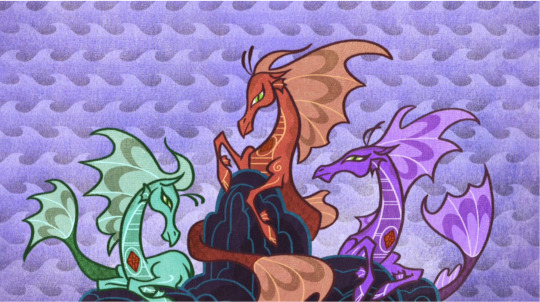

Way to take all the credit, Starswirl
We are shown how they are a sort of siren, who feed off of people’s negativity and discord and use their beautiful enchanted voices to cause mayhem. Kind of like a mix between Ursula the sea witch and Spectra from Danny Phantom. Oh my gosh, this is the second one of these reviews that I’ve brought up Danny Phantom. Maybe this is why Butch thinks he’s so popular.

The Dazzlings, we can infer, have been exiled to the EQG-verse from Equestria. So apparently this universe is like the pony version of colonial Australia, where they send all their criminals and miscreants. A solid plan that couldn’t have any negative repercussions. The sirens see a beam of light that must be the one from the last movie. This is good news for them, but bad news for me because now I have no idea how much time has passed the two films. Has it been a couple days? Weeks? Moons? This will make a difference in regards to why people still don’t trust Sunset. But why waste time setting up the story when we can get right into the remix title card?
At this point, I can only assume that principal Celestia threatened to expel students if they told the news or the FBI about the magical winged demon that attacked the school, because no one seems too concerned about that incident.
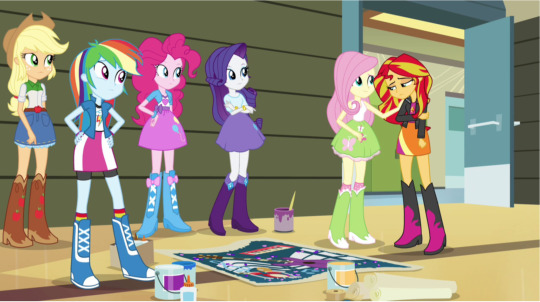
But they have plenty of time to hurt my baby’s feelings
I’m going to be honest, when I first watched EQG I thought that Sunset was faking her remorseful act after being defeated. As cool as that would have been, she makes a much better reformed bad guy than an antagonist, because she really wasn’t in the last movie that much.
List of “evil” things Sunset Shimmer has done: send fraudulent text messages and emails that honestly could have been pretty easily disproved, made fun of Fluttershy, made fun of the steamers in the gym, somehow divided the school into cliques, ran a mostly unsuccessful smear campaign against Twilight’s bid for dance princess, threatened to destroy the portal to Equestria, transformed into a demon to hypnotize the students, and she dissed the Apple cider.
Ok, that last one is pretty evil. But what really makes this and all subsequent movies great is that we get to see her learn and grow and change from the experience into a real friend.
I am glad to see that the Main 5 have forgiven her, but no one is quite ready to absolve her of guilt. Like, I might not think she did all that much bad junk, but the students of Canterlot High seem to think she was one tier below Mussolini in terms of maniacal dictators, so I don’t blame them for being cautious. It takes a lot to earn back trust.
Back in Equestria proper, the Mane six plus Spike are sitting around waiting for the plot to affect them. They kindly provide some exposition and once again setup the fact that only Twilight can go through the portal, because the others can’t interact with themselves. So we think. I will be bringing this up when we get to The Friendship Games.
Back through the portal, Twilight gets looped into the fact that Sunset has changed her ways. It’s fair to be a little apprehensive to trust someone who, the last time you saw them, was an actual literal demon. (Don’t worry though, Twi, you’ve still got two more unicorns to reform. It’s kind of your thing.)

Don’t reject her love Twilight, it’s all I have to live for
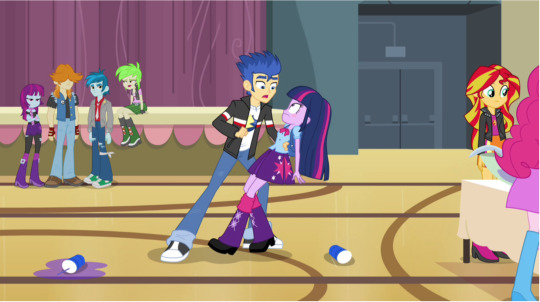
And now it’s time to discuss the small blue elephant in the room. I feel like I really need to explain why I dislike the addition of Flash to any of the plots. He’s kind of a waste of a potential. You want to add a male character: fine. But make them an actual real fleshed-out character. The show has proven that they can do it and do it well. Sunburst and Thorax are great characters who feel like a good addition to the story. And we got a real sense of who they were in one or two twenty minute episodes. I have no clue what this guy’s purpose is except to be a love interest, and this is not the show to do that with. With very few exceptions, the main characters of MLP have not sought out romantic partners, Twilight included. Why would she choose to do so now? I mean, I get why he’s into Twilight: she’s taken the form of a cute teenage girl. But he’s a species that doesn’t even exist in Equestria. She just fell through a portal and instantly got the hots for some weird otherworldly creature…
Wait a minute. Wait just a minute. Perhaps this isn’t compulsory heterosexuality. Perhaps Twilight Sparkle is just a Monster Lover™. I can respect that.
Moving on.
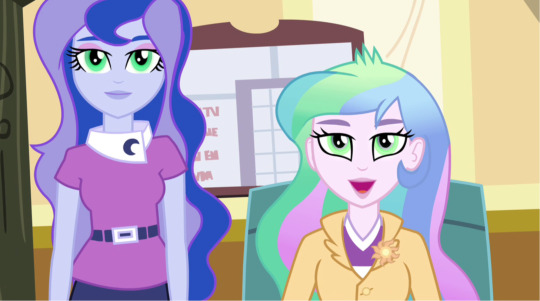
It was so very smart of the writers to have the Dazzlings brainwash the principals in order to get away with this scheme. That makes so much more sense and covers any plot holes that could arise (such as, someone claiming to be a new student despite having no transcript, no grades, and no knowledge of how to hold a pen).
Does time work differently between these two universes? Has it been months in Equestria but only a week in this world? (It really threw me off that the first four season of MLP took place over one year, and these movies don’t help that). And the sad thing is, this could be easily hand-waved away by a single throw away line, but it isn’t.
The Dazzlings are already better villains than Sunset, even from a character standpoint. We know their powers, we know their motivation, and we know they are capable of bringing about an actually believable rift between friends.
Then the best song, best montage, and possibly best scene in any of these films happen: the Dazzling come into the lunchroom and hypnotize everyone. This song is beautiful and eerie and exactly what you would expect a magic spell to sound like. I also enjoy the visual representation of the bands competing (and not just because I didn’t want to hear any of them perform) that we’ll see later. To give credit where credit is due, this movies has some great visual sequences.
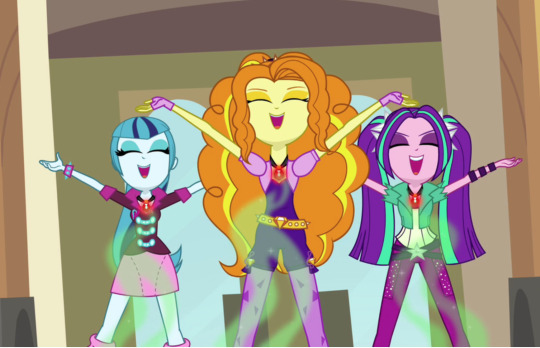
Give ‘em the o’l razzle dazzle
At first I thought it was unrealistic that this many kids had bands, but I realized it was probably an effect of the spell. But I might not be the best judge: I think I know maybe three people, plus myself, who don’t play an instrument. I’ll just assume that the Disney channel exists in this universe, and all these children just really want to be famous.

It’s worth sitting through this movie just to see everyone’s pajamas. That’s not weird, right? No really, the scene of them all having a big slumber party is everything I ever wanted from this series. They managed to capture everyone’s personality from an article of clothing. Now THAT’s good character design.

I get the distinct impression that the writers of this don’t like Rainbow Dash.
Oh good, references to technology that couldn’t possibly date this movie in the slightest. Wait… this is Pinkie’s house. Aren’t the Pies supposed to be like Amish or resembling Amish-type folk? What is the human equivalent of rock farmers? Not actual farmers because those exist in the pony-verse. This really confuses me, but Maude’s cameo is fantastic.

The scene with Twilight and Sunset is one of those really well-done moments that reminds me why I love the show so much. It feels really genuine, and supports my argument that it was worth having Sunset as a crappy villain just to reform her.
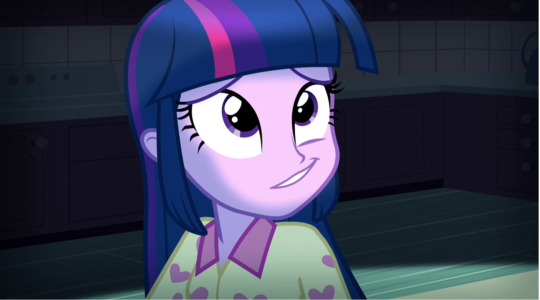

Ah yes, the sweet, lingering glances that totally platonic female friends share with each other late at night. I know them well.
Our girl Twily seems to be having trouble writing a spell that can double as a catchy pop song (She’s no Lana Del Rey), so they go with an old set list. How long has this band been operational? Weren’t they in a huge feud for several years?
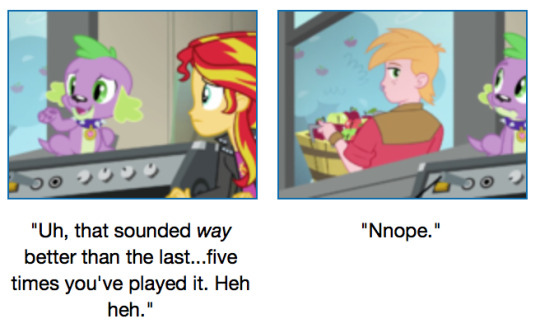
Mac is a close second for best cameo
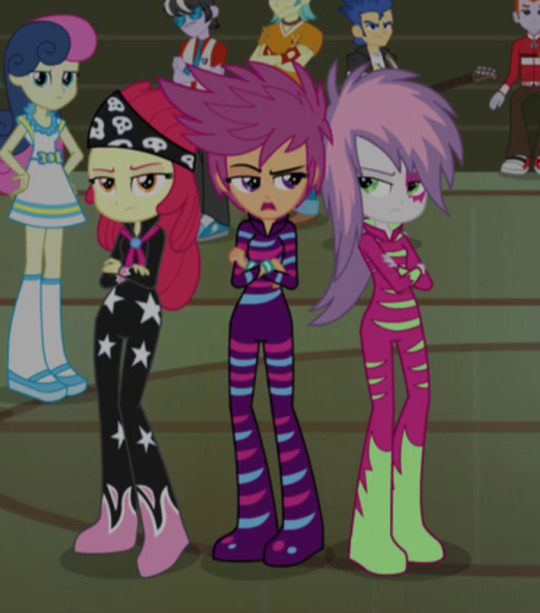
So we get to watch the band audition, and it goes about as well an actual high school talent show. The CMC are in the outfits from Showstoppers (which is hilarious) and Snips and Snails rap (which is disturbing). In order to keep my goblin brain from exploding while trying to figure out the ages of everyone, I’m just going to assume that this is a combination Middle School and High School. So, if Sunset won fall dance princess four years in a row, she would be in the tenth grade now, so they would be about 15-16. The Equestria Girls Holiday Comic shows Rarity driving a car, so that could be a possibility.
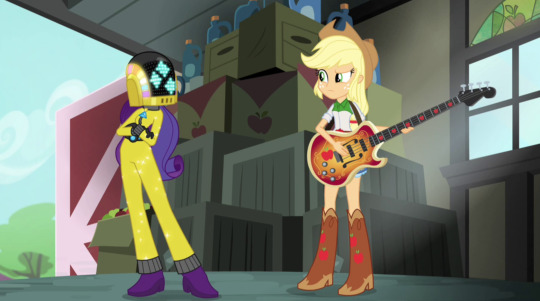
A. Daft. Punk. Reference. Wow. Just wow. (Note: this was more shocking before season five, when there was a character that was basically Lady Gaga. And by basically, I mean very obviously Lady Gaga. Remember when the pop culture references in this show were subtle?)
Dash’s song is quite possibly the most cringeworthy thing I have ever heard. The only defense is it does sound like something a high schooler would write.
On that note, why is Rainbow Dash the lead singer of the group? I mean, I know why, but WHY? (and yes, I am aware that her voice actress is a singer. But Ashleigh Ball uses her normal voice when she performs. Think back to all the songs RD has sung in the previous four seasons before this aired. There are not a lot of solos or high notes. When she sings as Applejack, it is beautiful, but Dash’s voice is grating sometimes)

Really? A battle of the bands is the greatest thing you’ve done at the school? That whole “stopping an actual demon with magic” was just a regular Friday for you? I’ll chalk that up to the brainwashing, otherwise I might go full on rage and throw my laptop out a window.
I guess our merry band of protagonists weren’t paying attention to big cafeteria scene, because they just now figured something suspicious is going on.

Still haven’t fixed the lights in that dim corner of lockers. Fortunately, there are many dramatic confrontations to be had.

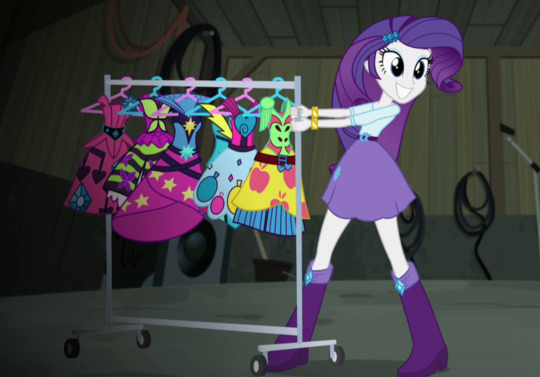

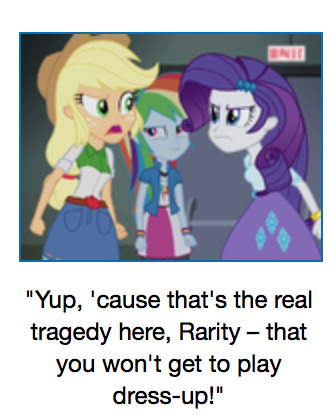
I think we’re supposed to see Rarity’s obsession with the outfits as a ridiculous thing, but I think it’s important to distinguish this universe from the one with the professional seamstress who has unicorn magic at her disposal. This is a teenager who has school, extracurriculars, and parents to contend with. If I went through the trouble to hand-make seven costumes for my friends, then found out no one would wear them, I’d be pretty ticked off as well.
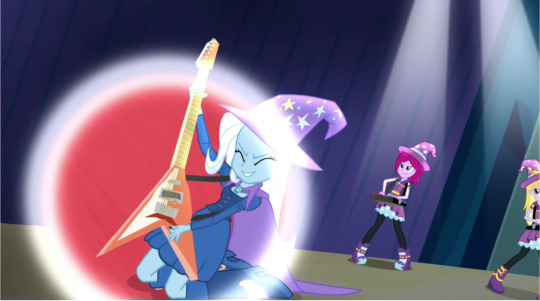
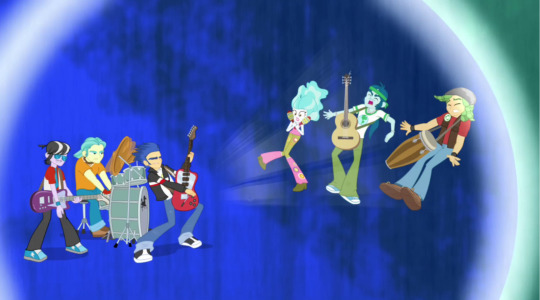
Now this is how you montage. We get to play a fun game of “guess which characters are in which band,” and seeing their “humanized” designs. Lotta bootcut pants in this show.

I’m just going to leave this here...
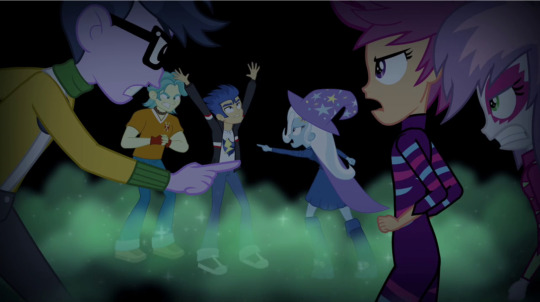
This is some actually effective villainy. The whole school has turned against each other. Maybe they need to learn about the magic of friendship. Unfortunately, the gang is too busy squabbling over band stuff, and Twilight is too distracted to give an overly emotional speech.
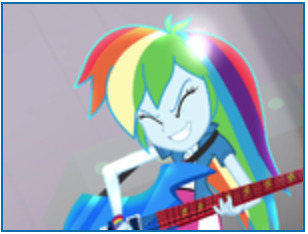
No one in the rule book does it say magically turning into a pony is grounds for disqualification...I would assume.
If we’re being honest here, the Dazzlings are better performers than the Rainbooms.
And we’ve come to the crux of things. The scene where they’re locked under the stage is the perfect example of my biggest issue with this movie. I do not like to see Mane 6 fight. I don’t like Trade Ya, I don’t like Putting Your Hoof Down, and I despise Look Before You Sleep. Seeing this otherwise close group of friends constantly have petty arguments, even if it’s for completely valid plot reasons, make me want to turn the movie off. This isn’t a criticism of the screenwriting, it is just a reason why I personally dislike Rainbow Rocks more than the other films.
Of course, they make up because this is about the magic of friendship and what not, but notice how no one actually apologizes for their behavior. No, “I’m sorry that I minimized your contribution to the group or made fun of something you were passionate about.” I realize they were under the influence of magic, but they also knew that! They knew the Dazzlings had the power to turn people against each other! An apology is just a preamble to fundamental behavior change, and if they don’t realize why they were being bad friends, how can they learn from anything?
And the real kicker is, they knew what the Dazzlings were capable of. Twilight read a book about them immediately before going through the portal. It’s not they they just learned that they spread chaos. Why are we fighting? Gee, I don’t know.
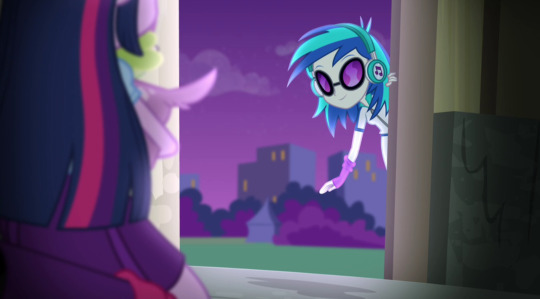
DJ-ex-machina. I’m ok with this.
To the movie’s credit, the finale really has one of the best song of the movie. And by that, I of course mean Trixie’s song. Trixie is the most fun addition to the cast. She makes for a fun antagonist, on her own and as a Pawn to the Dazzlings.

Fight scene! Fight scene! We’re gonna have a fight scene!
Now that they’ve put their petty squabbles behind them, it’s time for a big music battle. The Dazzlings pony up harness the energy of the audience to project their Equestrian selves to...I don’t know. Take over the world or something.

This isn’t even their final form
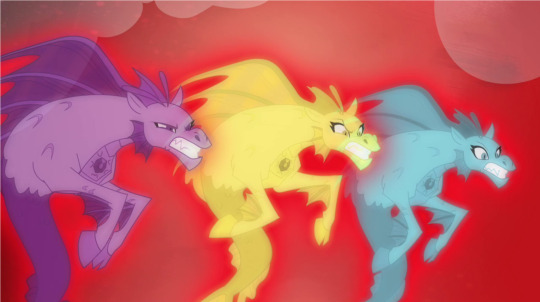
Oh. This design looked better in book form

Sunset is Magic. That’s the show.

So the stones auto-tuned them, and that made everyone mindlessly antagonistic. I’m sure there’s some clever commentary there.
T’was the magic of friendship that killed the beast.
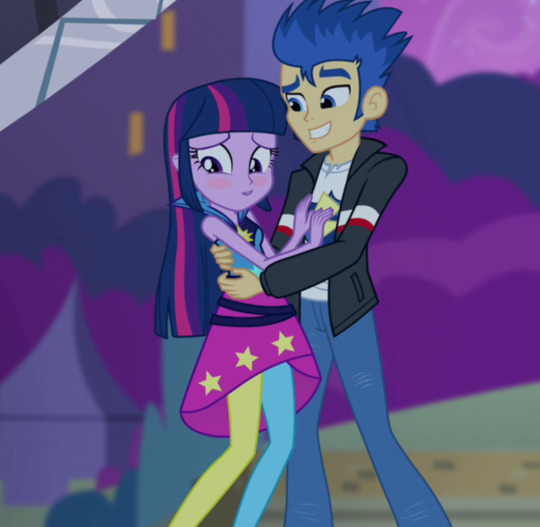
No, you don’t get to just rejoin the plot
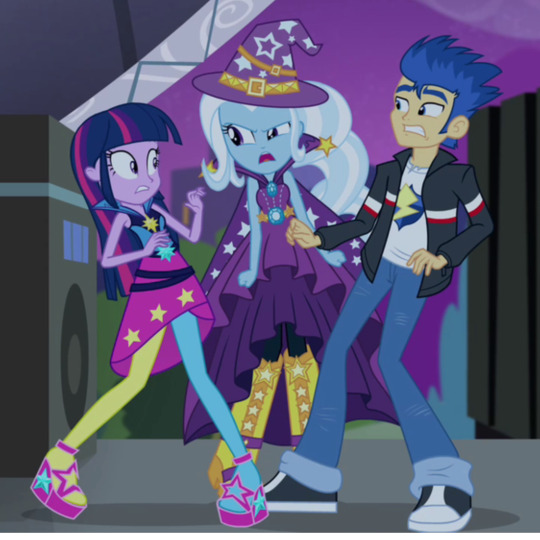
Thank you, Trixie.
The real story here is how Principal Celestia will pay off the press.
Thus Twilight goes back to the land of horses, Starlight has been truly forgiven, and my Netflix suggestions will never been the same again.
I want to give a big shout out to the person who put all the captions on the image gallery for this movie’s wikia page. They are funnier than I could ever hope to be.


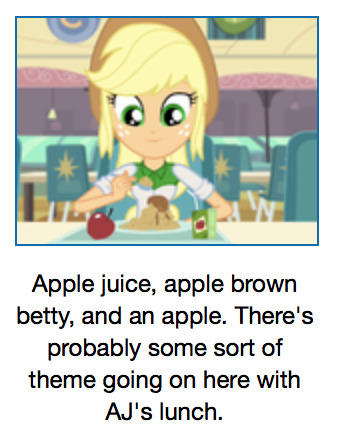
Some general thoughts:
The scene of Twilight awkwardly yelling “Friendship is magic!” to a room of confused teenagers is the cringiest thing I’ve ever seen, but it got a good laugh out of me. Look at the Dazzlings faces in this scene. “Ok, we legitimately didn’t see that coming.”
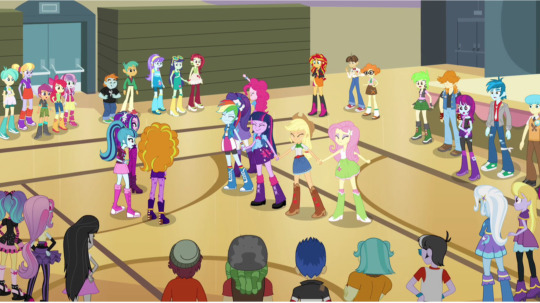
One of the reasons that I am so drawn to the show is that they are able to create conflict and drama without being mean-spirited. I have to deal with that kind of nonsense so much in my daily life, I just don’t want to subject myself to eighty minutes of it. But i get it: from a narrative standpoint, this is the most cohesive. There’s some good set up and pay off, and an actually intimidating villain who is actually present in the plot.
I love Trixie so much, I should be dead. She really is the star of the show. I forgot how little we saw of her before season six.

The stinger, oh the stinger. Forget what I said about the pajama party; it was worth sitting through this for the promise of an interesting sequel.
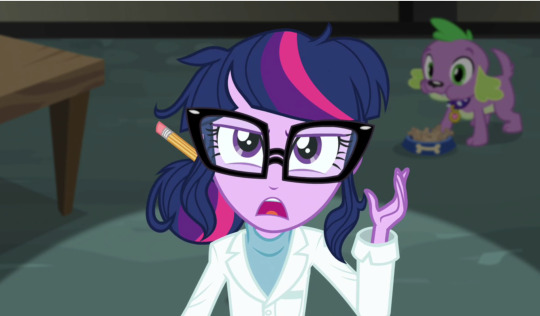
We’ll get to you soon, you marvelous lesbian disaster.
Starlight’s redemption is the best part of this franchise, and it’s worth all the nonsense to hear Rebecca Shoichet’s angelic voice.
From a purely film standpoint, this is probably the best one of the bunch. It has a clear structure, everyone’s motivations check out, there’s an actual climax that feels earned. I just don’t enjoy it. There are worse ways to spend eighty minutes 3.7/5
The worst thing to come from this, however, is the terrifying merchandise:


What Fresh Hell is This?
#MLP:FiM#MLP Equestria Girls#equestrian girls review#equestria girls#rainbow rocks#more of my opinions
40 notes
·
View notes
Link
In the early episodes of the acclaimed science fiction-spy drama Counterpart, Harry Lloyd’s Peter Quayle epitomized the organization man, devoting himself to pushing papers as the deputy director of Strategy at the Office of Interchange, the bureaucratic headquarters overseeing the portal to a parallel dimension opened accidentally in East Berlin during the Cold War. Placed in his high-ranking position partly thanks to nepotism, he was largely ineffectual, overpowered by both his superiors and his underlings—including JK Simmons’s Howard Silk, whose counterpart from the other world is a ruthlessly effective spy—and betrayed by his wife, who was eventually revealed to be a double agent.
The new season, however, has forced Quayle to act boldly with increasingly high stakes, bringing new vigor to a character who feels compelled to hide his wife’s secret in order to protect his family, even if it means having to deadbolt the door between their rooms at home. This season’s action has energized Lloyd as well, requiring a new intensity in his performance. “He has to be a different person with everyone he speaks to,” the English actor explains. “He has to sell a different lie. This season, I was concentrating much more on winning as much as possible the individual scenes knowing the risk that he’s going to ultimately fail and seeing how smoothly he can get through.”
As if that duality weren’t complicated enough, Lloyd also had to contend with Quayle’s recently introduced counterpart (known as Quayle Prime) in the alternate universe, whose life path has diverged from Quayle Alpha’s since the world cleaved in two in 1987. Kept in a holding facility where his memories and secrets are extracted for use against Quayle Alpha, Quayle Prime is, as Lloyd points out, distinct enough from his mirror image as to effectively be a second role. “It felt like doing another job for a few weeks in a way with all the same crew and the same actor, JK,” he recalls. “I hadn’t had any scenes with that character for ages because he’d been on the other side, so it was nice to hang out with nice Howard, but it was also nice to use a whole different set of muscles.”
In his extensive free time, Quayle Prime obsesses over a taped rugby match, identifying it as a point of difference that separates his life from Quayle Alpha’s—the former got lost and caused a scene, perhaps distracting a player, while the latter didn’t—and perhaps explains why he is being kept in what is effectively a penal colony while his other enjoys his success. For all its spycraft and copious bloodletting, Counterpart touches on deep issues of nature vs. nurture and the innateness of individual potential, forcing characters to ask themselves if they are better or worse than their mirror selves. For Lloyd, the arrival of Quayle Prime has helped solidify the contours of his main character. “Through this Quayle, you learn a bit more about Quayle Alpha,” he offers, “that he’s ultimately a child and that the entitlement and the smugness don’t come from malice. It’s just that he’s not been challenged and he’s unequipped but is still trying to get by through some path of least resistance. He knows he’s lucky and he knows that it’s run out and he doesn’t really know what to replace that with. Actually, I think they’re quite similar, they’re just in very different circumstances.”
Apart from these larger existential questions, there is also no question that a large portion of Counterpart’s success comes from its relevance to our own circumstances when no one on the internet is who he seems and spies and secret agents are once again a topic of national importance. Although set in contemporary times, the show has what Lloyd calls a “Cold War palette” thanks to its wan coloring and the use of Eighties technology, which is the only way the two dimensions can continue to communicate. “There’s been quite a lot of Cold War drama of late,” Lloyd muses. “It does feel that it’s had a revival because of its relevance today with the lack of trust and the difficulty of believing the motives of people in charge. It’s an interesting period where there are wars of a kind going on, but the battleground is somewhere else, yet things are happening behind closed doors in civilian circumstances. Much has changed, but much has not.”
Counterpart can seem in some ways like a natural successor to Lloyd’s last series, Manhattan, which presaged the Cold War in recounting the Manhattan Project to develop atomic weapons, but the 35-year-old says he was not ready to return to television so quickly after two years in Santa Fe away from his native London. “I’d just move back to England—literally my furniture had just arrived,” he recalls about reading the script for Counterpart, “but it was something I felt I really wanted to be involved in straightway. You’ve got to sign away seven years of your life and they made it really easy.”
Lloyd may have spent a fair amount of his past few years on television, but like most English actors, he got his start on the stage, performing in school plays as a way to set himself apart. “I went off to boarding school when I was eight and that first term I got the main part in the junior play, I think because I was good at reading out loud,” he recalls. “Quite quickly, I found a thing that other people didn’t do at school and found my own little niche. It became a hobby but also my little escape and something where I had a bit of an identity suddenly in a school with a hundred kids.”
His “little escape” quickly turned into a passion and he continued performing on stage throughout his time studying English at Oxford. He credits his coursework with giving him a unique perspective on acting, even if he admits it did complicate things inside his head at times. “I noticed when I was at college that sometimes the two were pulling in different directions,” he explains. “In my studies, I was breaking down the text and putting it into little pieces and working out the science behind the art and then when I was doing the plays, it was the opposite. I was trying to take all these different fragments and build it up into something real. In some ways, I found that quite frustrating at times, but actually, I think the two experiences—if you can keep them in check—served me really well. Those are the two necessary parts I think you need.”
After graduating, Lloyd continued to act, even as he imagined his time was running out. “I always thought I’d have to go and do something proper,” he laughs—but that never came to pass. He had early roles in the BBC drama Robin Hood in 2006 and in Arthur Miller’s A View from the Bridge on the West End and was part of the first season of Game of Thrones. Supporting roles in The Riot Cluband The Theory of Everything followed, along with Manhattan. He’s spent the last several years mixing film, television, and stage, but his natural curiosity continues to seek out even more. “I would like to get into other forms of stuff,” he enthuses. “I’ve done radio and audiobooks and I enjoy all the different sides of it. I’d like to do a video game, I’d like to get into VR. Nowadays there are more and more different platforms and I think they all require slightly different emphases from the performance and what the audience needs to believe. I’m definitely into what the next steps are, what actors will be doing in ten, twenty, thirty years time compared to what they were doing thirty years ago.”
But for now, Lloyd’s focus remains Peter Quayle—both of them. After last week’s midseason cliffhanger, which left Quayle Alpha splattered with blood and close to discovery, things promise to only get more complicated. Fortunately, all the added layers are exactly what drew Lloyd to the series in the first place, resulting in a show that does not offer easy solutions. “You start second-guessing people and you start exploring what lies people are telling,” Lloyd says of Counterpart’s continuing evolution. ”You’re not given the answer straight away, but it encourages you to try and piece together your own narrative. I find that really rewarding.”
Counterpart continues on Sundays on Starz and is available on the Starz app.
11 notes
·
View notes
Text
Yagiz + Hazan… HOW DID IT HAPPEN? | #review
Originally posted on Fb on February 13, 2018.
UNEXPECTED DISCOVERY: A Journey to Truth... and Love
There is a considerable amount of argument out there of the distinct difference between “INSTINCT” and “INTUITION" (and might I add, “INSIGHT” is usually a close echo after)—I’m sure many of you are privy to it. Shucks, there’s even argument of the precise definition of what each of them actually mean, let alone their distinctions from each other. It’s warranted. I myself wonder what the differences are, subtle and delicate they seem to me. Which then caused me to question, whether I myself accurately know their respective definitions in the first place. With enough investigative research, it appears that many, even those who are notably educated in the human psyche, have not really settled on a clear definition. But thank heavens, there is enough understanding of what they are that we all can find common ground where we can agree on their meaning. I won’t recapitulate a comprehensive exposition of the arguments for its scope goes both wide and thin but I will say this; yes, there is a difference between the two and yes, there are both psychological and physiological components associated with them. And yes, sometimes they are used interchangeably with each other but the simple fact of the matter is, without having to acquire a degree in psychology or biology, just a brief digital jaunt to Meriam Webster’s site or Wikpedia, and add to it Oxford’s for good measure, you’d get a comfortable idea of what “Intuition" is versus “Instinct".
Okay... WHY am I saying all this?
For authors and writers in general, knowing the definition and difference, even the philosophy, of any two words is quite necessary. Well, hello, words are what you need to tell a story, so it’s a no-brainer that nailing the definition of what something actually means is crucial. But to stop there, is to just remain at the mechanics and technical expectation of what a writer does. And that’s just a bit, uh—boring. But, now... In the CREATIVE space of what they do with what they know… Well, that’s a different ballgame.
Especially in Filmmaking.
(Ha! Some of y'all were probably wondering if you were still on a Fb group for FHVK, or ended up at a linguistics class instead 😝. Caglar trolls y’all all the time so what’s another nerd to put up with, right ✌️)
Here’s the thing. INSTINCT and INTUITION… I don’t think we truly realize just how much both of these two concepts are SHOWCASED in the Writers, Directors, and Cast’s portrayal of FHVK. Because I am truly a nerd 😆, I would decode the snuff out of something and with YagHaz, I’ve made some findings peppered throughout their story. And I gotta say, these two concepts are what made the relationship between Yagiz and Hazan quite enjoyable for me to analyze. (And hey, it might just be the same for y’all too—but the jury’s still out on that verdict till y’all conclude this review).
What’s more, I’ve discovered that decrypting what was instinctual and intuitive for them was just the TIP of the iceberg. Because these concepts only lead to significant INSIGHT (whad I say—close echo!) of what was truly, and DEEPLY going on between these two lovely, yet in so many ways, misunderstood people—though methinks the latter is only truest for Yagiz (but that’s for yet another time and discussion 😉).
If you’re ready for a long ride, allow me to explain further. But consider yourself WARNED—I’m notorious for writing super long reviews 😆. But what can I say, things worth gaining do take time. Pfft. Just look at the pace for these two adorkable characters. Long’n’slow be the Writers' middle name, yo.
I’ve broken this review into parts and you are now just concluding PART I. You can pause in between and save the reading for another time if you’d like. Do with it as you may—but I do hope you enjoy the ride!
PART II: INTUITION — Could It Be…?
Last review, we briefly covered on what was INSTINCTUAL for Hazan in this remarkable bond she shares with Yagiz. And believe me, there’s plenty more on that subject matter, not just for Hazan, but for Yagiz too—and it is quite mind-blowing on his part. I can’t wait to tell ya, but we’ll get to that later. Let’s first begin at the start of their journey.
When they first laid eyes upon each other on the 9th floor, in the 901st room of the Egemen hotel, both Yagiz and Hazan were under the influence of a LIE. It resulted in an intense confrontation on false premises of each other. But we also witnessed the electrifying chemistry between the two for the very first time as they clashed against and into each other. If that first brush with destiny as that rain puddle splashed onto Hazan as Yagiz passed by didn’t do it for ya, this hotel tryst is CLINCHER that the two were ENDGAME.
Two minutes into the encounter, the instinctual alarms were blasting off for both, pealing the message as they faced each other that the person standing before them was surely Bad News. Yagiz may have entered in already with his buttons pushed by Sinan’s deceptive tale, but the point is, a set of INSTINCTS in both were bred and sprung because of a single vile lie, which they believed for nothing but the truth at that point in time. To Hazan, Yagiz’ cryptic remarks denoted something oppressive and sinister, along with his dangerous eyes and icy tones. And to Yagiz, Hazan’s flummoxed reaction was just cheap trick to deny her harlotry whilst caught red handed. And so their instincts told them to defend, and ATTACK... Each other that is. And we got a showdown that literally drew blood. Yagiz thought she was a whore and Hazan thought he was a pimp. No wonder his face was cut. And no wonder she was thrown a Benjamin.
But here’s the good news; those instincts were bred by a FALSE reality... Which means there will be a different disposition altogether when the TRUE one emerges.
So HOW then, did these instincts we had gloriously witnessed in Hazan when she held on to Yagiz for dear life as the crowd watched upon her shame in E25 were birthed?
Well, that’s when INTUITION comes in.
Let’s take a look at Yagiz’ journey to understand what that means.
When things began to get disjointed for Yagiz concerning that hotel room incident, “something” began to niggle in his senses...
INTUITION.
It was telling him to seek the truth because things weren’t adding up, and so Yagiz followed a trail. But being on that path of discovery pit him against his immature, irresponsible, and selfish younger brother, to the point that not only was a construction project he’d committed sixteen months of his hard work and dedication was wrested from him, a two-year young company he’d started with 70 other dedicated people was shut down altogether. Which then led to his explosive revealing to his father, of the brokenness he had been carrying all this time because of the separation from his family. And so Yagiz chose to resign from his career and abandon that path of discovery entirely. It was costing too much of him. But he’d soon yet discover that it really wasn’t up to him… Fate somehow had kept linking them together; Hazan’s sister that he'd had to find and care for, Hazan's presence in his home as she embraced the sister he sheltered, Hazan's police arrest he'd witnessed and its reason that he had to solve—Yagiz unwittingly kept finding himself in the thick of things with all things Hazan (heck, they even began to share the same roof after her home caught on fire!), beginning with that historic hotel tryst, and on that path of discovery yet again and again, despite his previous attempts to bail. Eventually, the path led him to a key finding; Hazan had ripped the half-a-million lira check her mother tried to haggle out of his family. It was then that his initial INTUITION that first made itself known in E4 was proven right; a lie has been fabricated.
Hazan was not who he thought she was.
PART III: INSTINCTS — When A Man Loves...
There was a key phone call scene in E12 between Yagiz and Sinan, in which point Yagiz asked him what he finally wanted to speak to him about, and Sinan's answer was, “the first thing that you have in mind…”
Yagiz KNEW then, INTUITIVELY, that his younger brother was the perpetrator of the lie that had caused him to “trample the dignity” of an innocent girl.
The entire truth was finally revealed; And his INTUITION was the hand that wielded the SWORD that cut down the blinding veil of lies. And from then on,
A peculiar series of INSTINCTUAL behaviors from the aloof and independent Yagiz Egemen was put on display.
And his actions spoke ALOUD and OTHERWISE of what his words would eventually say on E14—that he has NEVER been in love...
Pfft. WRONG.
Buddy, you’re so smack dabbed in it, your soundtrack is a remix of Michael Bolton's “When A Man Loves A Woman” 😂
Allow me to explain why.
When Yagiz told a fib in E13, to interfere on Sinan’s confession to Hazan by offering her a deal to be the face of Egemenlar Cosmetics, some of y’all probably wanted to shake his head silly. I, for one, did. Why was this man covering for his cowardly, manchild brother’s sorry tail—a sentiment that Sinan even echoed. But what did Yagiz say? “THINK whether I saved you…
“I did it to save her.”
BAHAHA 🤣
Okay. Telling a lie to cover a lie is never a good idea. And telling a lie to save somebody is just an oxymoron—like “Civil War”; there’s nothing civil about wars, they are violent and brutal. Lies don’t really beget solution. Lies beget lies. Though I don’t condone his methods, I get why Yagiz did what he did. It was a quick fix that he could come up with in that moment. What I want to point out is not the fact that he could’ve handled the situation differently—because telling lies is never a good idea (shucks, isn’t he now suffering, some twenty episodes later, under the heavy weight of secrets and lies himself?)—but I’d like to cite the fact that his protective instincts were kicking up to safeguard the girl who he had once shamed; If Hazan found out that Sinan was the man responsible for disgracing her, Yagiz knew she’d leave their family mansion which was her shelter since a fire had ruined her home. His objective was to keep Hazan away from being homeless, especially after all that junk she’s had to go through. But this wasn’t even the first time we even saw him protecting her, isn’t it... A similar thing happened a few episodes before. Only that time, Yagiz was trying to protect and spare her from the cruel and humiliating fact that her mother was bargaining her (who he’d at that point thought was solely responsible for the lie, instead of his brother), when he said to Hazan that he only sent the lawyer to advocate her case because it was Sinan’s request—lying, because Sinan's initial objective was actually being Romantic Romeo, by landing himself in the cans to share the jail cell next to her, while Yagiz' was being out there trying to get her out.
(Mmm. Maybe there are girls who love those sort of things and call it “love", that a man landed himself in jail to join you there. But at the end of the day, TRUE love is about being someone RELIABLE. Someone who sacrifices and rescues. So it bears to think twice whether it was truly love or—yes it feels good, but still it was just—romance. Sure, Sinan eventually displayed the effort to rescue Hazan, which is credit to him. But Yagiz from the get go was trying to do that, retaining the perspective of what would serve and benefit Hazan more. Mark that at that time, that though he’s reserved a measure of intuition of the truth, the lawyer hasn’t even revealed yet that Hazan had ripped that check. So Yagiz was still under a lot of influence that Hazan was a ya-know-what, but still he sent the lawyer to help her, gave her the benefit of the doubt—speaks volumes of his character. So you tell me which should be the first choice—but the only choice, quite actually—of the worthy man of her heart.)
So where else do we see Yagiz protective instincts operating?
Remember when Yasin showed up with a gun trying to be the Grim Reaper for Yagiz’ soul? But Mr. Freezer here remained the cool headed guy he was, showing no indication whether he was worried for his own safety, only raising his voice once, and even that was to put an end to Yasin’s verbal attack on Hazan’s sister’s virtue, not his, and then continued to retain his chill.
Until Hazan decided to move towards the gun.
Yagiz sprung forward like the hounds of hell were at his heels, yelled her name with a rage, and pulled her body towards his. The look on Hazan’s face after, when she was in his arms... 🤣 Though we then proceeded to witness Yagiz' level-headedness in trying to set things in order afterwards, we briefly glimpse how much the whole ordeal ACTUALLY affected him. The three Camkiran women could’ve been down to two that night. Notice his ungainly walk to his car when he and Hazan had to make their way to the police station to give their testimony. Mr. Keep Cool no more, Mr. Jerky Movements he was; he abruptly stopped and looked back to assure himself that she was close behind him. And when he saw her, he just had to open her door 🤣. In the car, he was attuned to her movements. His ever perceptive eyes shifting between the road and her face, trying to detect any sign of stress plaguing her then finally asking, “Are you okay?” You could see the tension exuding off of him. The man was strung up; the anxious gulp, the worried eyes, the distorted face… though subtle they had. Yet what they are showing is that his protective instincts were kicking up again. And in his own cryptic way, he couldn’t stop himself from expressing that he took issues that she had put herself in danger. And guess what they ended up talking about 5 seconds later—like, literally?
REFLEX.
As in what comes to you INSTINCTUALLY…
Yeah. BAHAHAHA 🤣
So all these before E14 ever said hello, so err—still wanna tell me that Mr. Freezer here was “never” in love before?
And then alas, EPISODE 14 arrives. ✊
And what a HUUUUGE kicker it was!
But here’s the thing. In order from keeping this post stretching all the way to Istanbul, I’d have to call it a day. Because seriously, there is literally so much stuff going on in E14, flippin’ episode needs its own review all by its-oh-so-magnificent-self. I’m already struggling to keep this current review as succinct as possible. I couldn’t even fit some noteworthy epicness that should've really gone up above, but I shall try to on our next—and yes, mind as well warn you now—LONG ride 😆. So y’all stay tuned. Or go on a swim. Or take a long nap. Or go star gazing—heard Jupiter’s coming to prominence this time of the year. Whicheverhoo suits yo fancy! 😁
Been a pleasure, folks. 😎
#YagHaz#FHVK#Yagiz Egemen#Yagiz x Hazan#Review#YağHaz#fazilet hanım ve kızları#fazilet hanim and her daughters#my writing#television#screenwriting#filmmaking#storytelling#turkish drama#turkey#turkish#turkiye#dizi#english#writers#writing#lollipops and unicorns#writers on tumblr#writers on love#writers on writing#deep thinking#deep thoughts#writers on life#yağız egemen
15 notes
·
View notes
Text
ASOIAF: TPTWP and the significance of Jenny’s song
Since your better at doing the do with meta I thought I'd ask: D&D are putting a serious significance on ensuring it is always a STARK who saves Jon (Ned with his lie, Sansa at BotB & Benjen beyond the wall). I think that when D finds out abt Js parentage, she will make an attempt on his life. If the Starks come to the rescue again, I have a feeling it will be Bran... bt next ass save could be Arya. I also believed the PtWP and Azor Ahai were seperate. How likely do you think Pwtp = Bran & AA=J
Hello anon! Thank you for the ask, I dwelled on the prospect of Bran being TPTWP when you first asked this months ago and apologise for not getting back to you sooner, I wanted to make sure I had a better understanding on the subject so as not to respond ill equipped. I’m also choosing to answer this as a post itself instead of responding via ask box because this post is going to be lengthy and my ask box doesn’t warn me before accidentally exiting the window(it’s happened before and I don’t want to have to retype everything).
Bran’s arc, with the exception of Dany(her dragons), has been most tied to the more magical fantasy elements missing throughout the other POV chapters, so trying to logically map out what he’ll achieve or how he’ll go about being a prominent factor in the story to unfold is difficult. We know of some of the Three-Eyed-Raven’s abilities, but there’s so much more we don’t. And the issue of the Others has yet to be made clear. We don’t know for certain if the extreme of Ice is necessarily evil, only that it has the ability to become a destructive force. That being said, his journey in becoming the Three-Eyed-Raven would no doubt have a big impact on the story, and I think we can both agree he’ll likely have a hand in the war of the dawn or a conflict in the future.
As for him being TPTWP, you could argue that Bran was reborn amidst smoke and salt when he crawled out of the ruins of Winterfell when Ramsay burnt it down after hiding in the crypts, as the red comet was above them, and you could even go so much as to speculate that he’ll metaphorically wake a dragon in Jon, by revealing his parentage to him. Then there’s also the fact that Meera and Jojen refer to him as a prince(the Prince of Winterfell, after Robb becomes the King in the North). But there’s the issue of blood relations, and the prince that was promised is prophesied to come from the line of Aerys and Rhaella. This post will touch on that in greater detail in a moment.
First I think we have to reexamine the issue of TPTWP and Azor Ahai being separate entities. There are multiple different interpretations of Azor Ahai spread across Westeros and Essos: the North tells of a tale of the Last Hero, while the Rhoynish and YiTish have their own versions of the story as well, and then of course there’s the Asshai’i who dub him Azor Ahai, and then comes the prophecy of TPTWP. However no one in the series has ever distinguished between the two, and there’s no good reason to think this, as Melisandre, Aemon and GRRM all use it interchangeably:
“Westeros must unite beneath her one true king, the prince that was promised, Lord of Dragonstone and chosen of R’hllor,” - Melisandre, Davos IV (ASOS).
“It is the war for the dawn you speak of, my lady. But where is the prince that was promised?”
“He stands before you,” Melisandre declared, “…Azor Ahai come again” - Melisandre & Aemon, Samwell V (ASOS).
“[Stannis] is discarding the gods that he has worshipped since childhood and accepting the Red God, and giving himself to the Lord of Light, and in return Melisandre sees that the Lord of Light gives him a token of his role as the prince that was promised by ancient prophecy, and that’s the sword Lightbringer,” - GRRM in Game of Thrones Season 2 Religions of Westeros.
So I apologise for disappointing you but I’m of the opinion that TPTWP and AA are the same person, or at least the same entity. With that made clear, we can now proceed to predict in this post, whom I believe TPTWP/AA reborn is, and in order to do that, we must first look at the criteria of what makes TPTWP.
(this meta will touch on the prophecy of TPTWP/AA, Jon&Dany & how they fit the criteria respectively, the Tragedy of Summerhall and how it involves Aegon V, Rhaegar and the Ghost of High Heart, as well as the significance of Jenny’s song, and Dany’s vision in the HoTU, so buckle up and grab a snack because it is lengthy! and under the cut)
The Prince that was Promised | Azor Ahai
Melisandre believes that AA is prophesied to be born under a bleeding star, as does Maester Aemon, and few others:
“When the red star bleeds and the darkness gathers, Azor Ahai shall be born again amidst smoke and salt,” - Melisandre, Davos III (ASOS)
“a prince that was promised… the bleeding star… the one, born amidst salt and smoke,” - Maester Aemon, Samwell IV (AFFC)
“Benerro has sent forth the word… the fulfilment of an ancient prophecy. From smoke and salt she was born to make the world anew. She is Azor Ahai returned.” - Haldon, Tyrion VI (ADWD)
“Born amidst salt and smoke, beneath a bleeding star. I know the prophecy.” - Marwyn, Samwell V (AFFC).
“...Rhaegar was certain the bleeding star had to be a comet,” - Maester Aemon, Samwell IV (AFFC)
So it’s known so far that the (i) Bleeding Star, and the (ii) Salt and Smoke, are part of the criteria.
-----
Another sign is red or burning sword called Lightbringer:
“In ancient books of Asshai it is written that… a warrior shall draw from the fire a burning sword. And that sword shall be Lightbringer, the Red Sword of Heroes, and he who clasps it shall be Azor Ahai come again, and the darkness shall free before him,” Melisandre, Davos I (ACOK)
“a prince that was promised… The prophecy …[Stannis’] sword is wrong… light without heat… and empty glamor… [Stannis’] sword is wrong, and the false light can only lead us deeper into darkness,” - Aemon, Samwell IV (AFFC)
and in Sam’s readings, he also stumbles upon the fact that the last hero(the North’s rendition of AA) defeated the Others using Valyrian steel:
“I found one account of the Long Night that spoke of the last hero slaying Others with a blade of dragonsteel. Supposedly they could not stand against it”
“Dragonsteel?” Jon frowned. “Valyrian steel?”
“That was my first thought as well,” - Samwell I (AFFC)
One account of the legend suggests it has to be tempered from a sacrifice of Azor Ahai(his sacrifice was of his wife, Nissa Nissa):
“Azor Ahai… Lightbringer was his sword. Tempered with his wife’s blood if Votar can be believed,” - Jon III (ADWD)
Davos speculates that AA would have to make a similar sacrifice but it’s important to note that it’s never said to be part of any prophecy so a sacrifice might not actually be required.
------
Both Maester Aemon and Melisandre speculate that dragons would be involved:
“a prince that was promised… the prophecy… Daenerys is the one, born amidst salt and smoke. The dragons prove it,” - Maester Aemon, Samwell IV (AFFC)
“Azor Ahai shall be born again amidst smoke and salt to wake the dragons out of smoke and stone.” - Melisandre, Jon X (ADWD)
but on waking the dragons out of stone, it’s important we take her word with a grain of salt, considering she admits herself she’s made errs in interpretation:
“sometimes I have mistaken a warning for a prophecy or a prophecy for a warning.” - Melisandre, Davos V (ASOS)
“Many a priest and priestess before her had been brought down by false visions, by seeing what they wished to see,” - Melisandre (ADWD)
“we all deceive ourselves, when we want to believe. Melisandre most of all, I think.” - Aemon, Samwell IV (AFFC)
With that in mind, it seems possible she’s wrong about the stone dragon, but all agree that the prophecy is at least associated with dragons.
------
Lastly and possibly most important in distinguishing TPTWP, is that it’s prophesied by the Woods Witch that TPTWP would be born from the line of Aerys II(The Mad King) and Rhaella Targaryen. The significance of the Woods Witch will be explored further in a moment, but for now let’s acknowledge the final candidates that fit this criteria of TPTWP, because while most characters have instances that could be taken as signs of them being TPTWP/AA reborn, only two living characters fit this one: Jon and Daenerys.
Let’s recount the criterion so far:
a bleeding star
born amidst smoke and salt
a burning sword
an association with dragons
born from the line of Aerys II and Rhaella Targaryen
now let’s briefly(because I intend to expand certain things further and do not intend to drag this out longer than it already is, and Daenerys is one of the main and widely accepted candidates for AA already) explore how much either candidate fits this image.
The Case for Daenerys
she sees the red comet the day she burns Drogo’s funeral pire,
born on Dragonstone(amidst salt from the sea) and reborn as the Mother of Dragons(amidst smoke, and arguably also salt from the sweat and tears of Miri Maz Duur),
literally woke dragons out of stone(Dragon eggs),
is the child of Aerys II and Rhaella Targaryen, and,
her dragons could metaphorically be the flaming sword, as suggested by Xaro Xhoan Daxos’ description of them:
“your dragons [are] a flaming sword above the world” - Xaro Xhoan Daxos, Daenerys III (ADWD)
and now, let’s examine the points for Jon.
The Case for Jon
In the chapter where he gets betrayed and stabbed, he mentions a promised prince, and along with that, certain things are mentioned that could be taken as points toward him being TPTWP:
“A promised prince, born in smoke and salt.” - Jon XIII (ADWD)
“a bloody corpse… cloak… patterned with blue stars. Blood and bone were flying everywhere heralds was… distinctive.” - Jon XIII (ADWD)
“Bowen Marsh stood there before him, tears running down his cheeks,” - Jon XIII (ADWD)
“the wound was smoking,” - Jon XIII (ADWD)
So already present in that chapter is not only a reminder of the prophecy but of the criteria of smoke, salt and a bleeding star. Moreover, we know now that Jon was born in the Tower of Joy, and Arthur Dayne was amongst those that stood guard of that tower. Coincidentally(or not), the ancestral sword of House Dayne, ‘Dawn’, was forged from a fallen star. So that’s an extra bit of support in his birth as well.
So, assuming we take that to account for the star and smoke and salt:
Jon will be reborn amidst smoke and salt,
his rebirth will be under a bleeding star(though it could be interpretated that the bleeding star only heralds the coming of TPTWP, so the red comet could apply regardless),
he is one of the only characters to wield a Valyrian steel sword,
he is like to metaphorically “wake” a dragon in himself once he’s told of his parentage, and,
he is born of the line of Aerys II and Rhaella Targaryen
+ whenever Melisandre tries to see Azor Ahai in her visions:
“I pray for a glimpse of Azor Ahai and R’hllor shows me only Snow” - Melisandre (ADWD)
Additionally, Jon also has a dream he wields a burning red sword:
“That night he dream[ed] … He stood atop the Wall, alone. “Flame,” he cried … Jon was armoured in black ice, but his blade burned red in his first. As the dead men reached the top of the Wall he sent them down to die again. He slew … a girl with thick red hair. Too late he recognised Ygritte.” - Jon XII, (ADWD).
That’s some pretty damning evidence especially if we consider the sacrifice that mirrors the original tale of Azor Ahai.
So keeping in mind that both Jon and Daenerys fit the criteria of TPTWP the most of all the characters, what then further sets them apart? The significance of the Woods Witch and Jenny’s song. And to dive into that(stay with me!), we’ll have to examine three prominent figures to better dissect the Tragedy at Summerhall:
Aegon V,
Rhaegar Targaryen and,
The Ghost of High Heart.
1. Aegon V Targaryen
Now in the books, King Aegon V Targaryen was grandfather to King Aerys II(The Mad King), but in show!verse, he is the father of Aerys II instead of Jaeherys II -- the show skipped Jaeherys’ entire generation, but kept two of his siblings, Duncan and Daeron, making them Aerys II’s siblings instead.
Here’s are screencaps(the first is book!verse, the second is show!verse) for your comparison of how the Targaryen family tree was reduced for simplicity’s sake:


Let’s proceed.
Aegon V was prophecy obsessed, and this obsession with prophecy within the Targaryen household was brought upon since King Aerys I(noted to be well read) read something which prophesied the return of dragons. Like Aerys I, Aegon V believed that the only way people would fully submit to their rule is if they had dragons once again.
You’ll notice that Jaeherys II(or in show!verse, Aerys II Targaryen) succeeded the throne despite having an older brother, Duncan Targaryen(show!verse made him Aerys II’s brother). This is due to the tale of Duncan and Jenny, which if you aren’t familiar with, to put it simply: Aegon V’s son, Duncan Targaryen, married a lowborn maid, Jenny of Oldstones, forfeiting his rights to the throne and passing it to his brother, King Jaeherys II(show!verse, his brother would be Aerys II). This bit of information is important because when Jenny came to court in King’s Landing, she brings along the Woods Witch who prophesied TPTWP being born of Aerys II and Rhaella’s line along with her. Because of this, he commanded Aerys II and Rhaella to wed, and thus they did, although unhappily:
“Your grandsire commanded it. A woods witch had told him the prince that was promised would be born of their line.”
“A woods witch?” Dany was astonished.
“She came to court with Jenny of Oldstones. A stunted thing, grotesque to look upon. A dwarf, most people said, though dear to Lady Jenny, who always claimed that she was one of the children of the forest.” - Barristan Selmy, Daenerys (ADWD)
Aegon V’s final years were dominated in search of ancient lore and text in dragon breeding, he even commissioned journeys all over the world to search for hidden knowledge on the matter. He ends up devising a ritual in an attempt to hatch some dragon eggs, and this takes place at Summerhall. He summoned his family and friends to celebrate the birth of Rhaegar, while performing the ritual. The ritual backfires however, and Aegon V loses his life along with Prince Duncan, his son, and Jenny of Oldstones, in what goes onto be known as the Tragedy at Summerhall.
With that bit of lore about the Tragedy at Summerhall in mind, let’s dive into what we know of Rhaegar Targaryen.
Rhaegar Targaryen
Rhaegar was noted to be bookish to a fault:
“the Prince of Dragonstone was bookish to a fault. he was reading so early that men said Queen Rhaella must have swallowed some books and a candle whilst he was in her womb.” - Barrister Selmy to Daenerys (ASOS)
and what little we know of him suggests he was prophecy obsessed. But he also has a strange obsession with the Tragedy at Summerhall:
“Viserys had spoken of Rhaegar’s birth only once. Perhaps the tale saddened him too much. It was the shadow of Summerhall that haunted him, was it not?”
“Yes. And yet Summerhall was the place the prince loved best. He would go there from time to time, with only his harp for company. Even the knights of the Kingsguard did not attend him there. He liked to sleep in the ruined hall, beneath the moon and stars, and whenever he came back he would bring a song. When you heard him play his high harp with the silver strings and sing of twilights and tears and the death of kings, you could not but feel that he was singing of himself and those he loved.” - Ser Barristan, Daenerys (ASOS).
But there is textual evidence that is reason enough to believe that his obsession with the tragedy and in visiting Summerhall has to do with his obsession with the prophecy of TPTWP.
Still with me?
We know from Maester Aemon that Rhaegar had once assumed he was TPTWP, and that something changed that made him realise his son would be:
“No one ever looked for a girl,” he said. “It was the prince that was promised, not princess. Rhaegar, I thought… the smoke was from the fire that devoured Summerhall on the day of his birth, the salt from the tears shed from those who died.” - Maester Aemon, Samwell (AFFC).
“He shared my belief when he was young, but later became persuaded that it was his own son who fulfilled the prophecy, for a comet had been seen above King’s Landing on the night Aegon was conceived, and Rhaegar was certain the bleeding star had to be a comet. - Maester Aemon, Samwell (AFFC).
“Until one day Prince Rhaegar found something in his scrolls that changed him. No one knows what it might have been, only that the boy suddenly appeared early one morning in the yard as the knights were donning their steel. he walked up to Ser Willem Darry, master-at-arms, and said, “I will require a sword and armor. It seems I must be a warrior.” - Barrister Selmy, Daenerys (ASOS).
So the question is, what led to this change? Or rather, who let him in on it? I have reason to believe that it could have to do with the Ghost of High Heart.
The Ghost of High Heart
Now, many people believe that the Woods Witch Jenny of Oldstones brought with her to court had died in the fire along with Jenny, Aegon V, Duncan and everyone else at the Tragedy of Summerhall. But there’s textual evidence which suggests she went on to live as the Ghost of High Heart.
The Ghost of High Heart(excluded from the show) is an old, stooped, short woman who lives at High Heart in the Riverlands, and had white long hair with pale flesh and eyes that bleed red. Her appearance is similar to that of the Woods Witch that Jenny brings to court, but more importantly, she too has visions of both the future and the past:
“The old gods stir and will not let me sleep. I dreamt a shadow with a burning heart butchering a golden stag(Stannis killing Renly), aye. I dreamt of a man without a face, waiting on a bridge that swayed and swung. On his shoulder perched a drowned crow with seaweed hanging from his wings(Euron’s murder of Balon Greyjoy). I dreamt of a roaring river and a woman that was a fish. Dead she drifted with red tears on her cheeks(Lady Stoneheart), but when her eyes did open, oh, I woke from terror. All this I dreamt, and more.” - The Ghost of High Heart to the Brotherhood, Arya (ASOS).
“She has her own ways of knowing things, that one. The weir woods whisper in her ear when she sleeps.” - Thoros, Arya (ASOS).
The Brotherhood visits her to hear of her prophetic dreams, and in return she always asks for a song as payment, Jenny’s song.
Jenny’s Song
Jenny’s song, as aforementioned, is always requested by the Ghost of High Heart as payment in exchange for telling the Brotherhood Without Banners of her prophetic dreams. Tom of Sevenstreams sings it for her, accompanying the words with his woodharp, and the song is soft and sad in nature:
“She always makes me sing the same bloody song.” - Tom of Sevenstremas to Arya, Arya (ASOS)
“Let her savour her song in peace. It is all she has left.” - Thoros of Myr, Arya (ASOS)
“Oh, aye. My Jenny’s song. Is there any other?” - TGoHH, Arya (ASOS)
When sung, the Ghost of High Heart sings along quietly and sobs for her Jenny. The only known lyric to us suggests a connection to the tragedy of Summerhall:
“High in the halls of the kings who are gone, Jenny would dance with her ghosts…” - Arya (ASOS)
Jenny’s song, is clearly about none other than Jenny of Oldstones(who brought the Woods Witch to court). “...the halls” suggest the court of King’s Landing, tied by “of the kings who were gone” that clearly references the Targaryens who once lived and reigned in King’s Landing. “...Jenny would dance with her ghosts...” alludes to the people Jenny loved, her friends and family, that are now ghosts that have died with her at Summerhall. It explains why the Ghost of High Heart cries, because the song is a tragic memory.
Her encounter with Arya(recreated in show!verse with Melisandre instead) supports this as well. When she meets Arya, she becomes extremely frightened by her presence:
“I see you. I see you, wolf child. blood child. I thought it was the lord who smelled of death… You are cruel to come to my hill, cruel. I gorged on grief at Summerhall, I need none of yours. begone from here, dark heart. Begone!” - Arya (ASOS).
she mentions that she “gorged on grief at Summerhall.” So both the Woods Witch and the Ghost of High Heart are similar in appearance, have a dear friend named Jenny, was present at Summerhall, and have prophetic dreams. That’s evidence enough to assume that the Woods Witch survived the Tragedy at Summerhall, and went on to live as the Ghost of High Heart. This could explain why Rhaegar was constantly visiting Summerhall in his early years.
While there is no concrete evidence of Rhaegar ever meeting the Ghost of High Heart, there are subtle clues that suggest as much. Firstly, when Daenerys asks Ser Barrsitan:
“It was the shadow of Summerhall that haunted him, was it not?” - Daenerys (ASOS).
considering that the Ghost of High Heart gorged on tragedy(suggesting she dwelled there for awhile), the wording choice of “haunted” could therefore hint at the Ghost of High Heart, and her ““haunting”” could just as well mean her meetings with Rhaegar whenever he visited. In other words, the Woods Witch can therefore be viewed as the Ghost haunting the halls of Summerhall.
Secondly, we know that Rhaegar would visit only with his harp and would return with a sad song, singing of tragedy and kings who died. The one line we know of Jenny’s song references the tragedy of house Targaryen and we know it’s a sad song evident by the Ghost crying for her Jenny every time. It’s then very possible to assume that Rhaegar wrote Jenny’s song. He was known as a skilled musician especially with his harp. Moreover, we know his songs and playing have brought tears to people before, Lyanna for example.
Jenny’s song is known as a tragic and sad song, just the type of song he would sing to bring people to tears. Who else would know of these events so well? The song being accompanied with a woodharp also connects Rhaegar to it because it’s the instrument we know he plays.
So, similar to the Brotherhood, you could assume Rhaegar visited Summerhall often to meet the Woods Witch, and he rewards her with a song: Jenny’s song. Rhaegar initially believed that he was TPTWP, but you could further accredit this to the fact that for years he was the only child(Rhaella suffered still births and infant mortalities) until Viserys. His change of heart is still a mystery but maybe the Woods Witch/the Ghost of High Heart expanded on his prophesy. With Rhaenys and Aegon(his children with Elia Martell) gone, Jon Snow is the only contender. Perhaps the Woods Witch told him that TPTWP has to be born of not only the Targaryen line but also the Stark line, thus prompting Rhaegar to pursue Lyanna Stark.
I’m wrapping up, promise...
Daenerys’ vision in the HoTU
Textual evidence suggests that Rhaegar may have hid the prophecy in Jenny’s song: something that could never be destroyed. The best evidence we have of this is in Daenerys’ vision in which Rhaegar appears in an apparent flashback:
“Viserys was her first thought the next time she paused, but a second glance told her otherwise. The man had her brother’s hair, but he was taller, and his eyes were dark indigo rather than lilac. “Aegon,” he said to a woman nursing a newborn babe in a great wooden bed. “What better name for a king?”
“Will you make a song for him?” the woman asked.
“He has a song,” the man replied. “He is the prince that was promised, and his is the song of ice and fire.” He looked up when he said it and his eyes met Dany’s, and it seemed as if he saw her standing there beyond the door. “There must be one more,” he said, though whether he was speaking to her or the woman in the bed she could not say. “The dragon has three heads.” - Daenerys (ACOK)
presumably, the woman is Elia Martell with the first Aegon, and it looks like a vision of the past but visions in ASOIAF as we know, are tricky and seem to span into almost an alternate timeline. So let’s assume instead that it’s a glimpse into the future that never was, just like Daenerys’ vision of her dead son:
“A tall lord with copper skin and silver-gold hair stood beneath the banner of a fiery stallion, a burning city behind.” - Daenerys (ACOK).
it’s also important to note that there is no physical description of the woman, so it could just well be Lyanna Stark. Show!verse has already confirmed Jon’s true name as Aegon, and that he’s the true heir to the Iron Throne - this coincides with the vision of Rhaegar naming him Aegon, a name fit for a king. It also makes sense then why he says his song is the song of ice and fire. Rhaegar would represent fire and Lyanna, ice.
He looked up when he said it and his eyes met Dany’s, and it seemed as if he saw her standing there beyond the door. “There must be one more,” he said, though whether he was speaking to her or the woman in the bed she could not say. - Daenerys (ACOK)
Seeing as Jon is a few months older than Daenerys, this statement makes sense continuity wise as well. But as to why the dragon must have three heads or what it could possibly mean(I’m of the opinion that the two other people are meant to aid TPTWP) is another issue for another day.
Rhaegar then plays the harp and a sweet sadness fills the room:
“He went to his window seat, picked up a harp, and ran his fingers lightly over its silvery strings. Sweet sadness filled the room as man and wife and babe faded like the morning mist, only the music lingering behind to speed her way.” - Daenerys (ACOK).
They all fade away but the song lingers on suggesting the idea that while we all eventually die, songs live forever. This would be why Rhaegar hid the prophecy in Jenny’s song. Where scrolls and old texts can be destroyed and damaged with age, songs live forever and are passed down - immortalising our heroes and celebrating our triumphs.
Finally, both Jenny’s song and the song of ice and fire have no official names. While every song mentioned in the novels or show has names, they are the only two songs without. So when Rhaegar tells Lyanna that he(Aegon) already has a song, the song of ice and fire, he could be referring to Jenny’s song - the song that conceals and protects the Woods Witch’s prophecy.
We know that ASOIAF/GoT is at its base, an anti-war story. Both Ice and Fire have the means of absolute destruction. This is why I’m of the belief that TPTWP/AA reborn, must not only be born to the Targaryen line, but of the Stark line too. He must have the blood of Old Valyria and the First Men, it adds a layer of depth to the importance and significance of Jon Snow’s parentage. Where Daenerys represents the extreme of Fire and the Others represent the extreme of Ice, Jon Snow is the son of ice and fire. He has that something extra that distinguishes him from Daenerys as a contender for the title of TPTWP.
Rhaegar hid the prophecy where it can be heard, yet can never be destroyed. He hid it within the song of ice and fire.
Thank you for the ask! I apologise for the length but there’s no way around that without missing out crucial points to consider. Very sorry for the delay though, I hope you didn’t think I was avoiding it on purpose! Also if there are typos or grammar errors just know I didn’t proof read this, thanks for putting up with me!
41 notes
·
View notes
Text
Star Trek: Discovery Season 3 Episode 5 Easter Eggs & References
https://ift.tt/eA8V8J
This Star Trek: Discovery article contains spoilers for Season 3, Episode 5.
Because everything in the 32nd century is brand-new for the Star Trek canon, it would make sense that the writers of Star Trek: Discovery could get away with not really referencing anything from the existing canon. To put it another way, how much do you really know about the year 1090 off the top of your head? The gap between Discovery’s point of origin in 2258 and 3188-3189 is huge. And yet, nerdy Star Trek Easter eggs and HUGE call-backs to some of the most beloved ships and characters ever, endure.
From a surprise cameo from a famous film director, to a lesson in Mirror Universe history, and yes, the appearance of Captain Janeway’s beloved starship, here are all the Easter eggs we caught in the latest Star Trek: Discovery episode, “Die Trying.”
“Federation and Starfleet Headquarters”
Saru notes that the ship is en route to “Federation and Starfleet Headquarters,” and then points out that these are “separate entities that now must abide together.” Although sometimes used interchangeably, this distinction is relevant. Starfleet actually predates the Federation and is an exploratory organization, analogous with what might happen if NASA and the Navy were combined in space. The United Federation of Planets, on the other hand, is the government. Starfleet and the Federation are not the same things, except now, as Saru points out, in the 32nd Century, they kind of are.
New Constitution
Owo sees what she describes as a “new Constitution.” This can only refer to what she infers is an upgraded version of a Constitution-class starship. The NCC-1701 Enterprise was one of 12 Constitution-class ships in service in Joann Owosekun’s time.
USS Voyager and USS Nog
The crew very prominently sees and talks about the USS Voyager NCC-74656-J. Owo and Tilly confirm that the “J” constitutes 11 “generations of evolution.” It is unclear if this means that this is literally the same Voyager from the 24th Century, or if the “J” means that this is the 11th ship to carry the name, “Voyager.” Elsewhere in the Starfleet Headquarters, barely visible is the USS Nog. Clearly, this was named for the Ferengi Nog from Deep Space Nine. Played by the late Aron Eisenberg, Nog was the first Ferengi in Starfleet.
New Starfleet uses the TNG coloring
Admiral Charles Vance and the rest of the 32nd Century Starfleet seem to use the color-coded system from the TNG era. Command officers still appear to sport red, while stripes of gold and blue are visible on other uniforms.
Kaminar Joined the Federation
Saru is thrilled to learn that Kaminar became a Federation planet sometime after Discovery jumped into the future. Because we never heard from Kelpiens in the 23rd or 24th century, it seems likely they joined the Federation at some point after that. In the Short Treks episode “The Brightest Star,” we learned the Prime Georgiou rescued Saru from Kaminar, but that Saru couldn’t return there because of issues with the Prime Directive. In Discovery Season 2, the ship returned to Kaminar in “The Sound of Thunder,” but Kaminar definitely didn’t enter the Federation at that point.
Sigma Draconis System References “Spock’s Brain”
One unnamed officer tells Admiral Vance that the “Emerald Chain” — an alliance of Andorians and Orions — is up to no-good in the “Sigma Draconis” system. This is the same star system from the TOS episode “Spock’s Brain.” Let’s hope that Spock’s brain hasn’t been stolen — again.
The size of the Federation
For the first time ever, the size of the Federation has been firmly established, not just now, but also, prior to the current timeline. Vance tells Saru and Burnham that there are “38 member worlds” in the Federation right now, but that because of bad communications, it’s possible that there may be more. Vance also says this number is “down from 350 at its peak.” We knew there were a lot of planets in the Federation in TNG, but we really had no idea exactly how many.
Starfleet Federation combo
As mentioned by Saru in the opening monologue, Vance doubles-down on the idea that “Where we sit now represents not only the headquarters of Starfleet Command by also the entire civilian government of the United Federation of Planets.” It’s unclear at this point if there are civilian government officials still operating, or if Vance is saying that he is basically Starfleet and the Federation at the same time. He also says that everything has “been that way since the Burn.”
Zero records of Discovery is basically Spock’s fault
Vance says “our records show Discovery was destroyed in 2258.” Saru implies the files would have been erased by Starfleet for safety reasons. But, the truth is, Spock is the one who erased the stuff about the Spore Drive. We saw Spock take these steps in “Such Sweet Sorrow Part 2.”
A War to Uphold the Temporal Accords
Admiral Vance’s “quick history lesson” mentions that the Federation spent most of the 30th Century fighting “a war to uphold the temporal accords” which he says is an “interstellar treaty outlawing time travel.” This references the prequel series Star Trek: Enterprise, and basically establishes that the “Temporal Wars” alluded to by Book in “That Hope Is You Part 1” are the same Temporal Wars that Daniels pulled Captain Archer into. It also seems that the Temporal Wars may have continued in the relative “present” beyond what we saw Daniels doing in Enterprise.
The Discovery crew drops references for their entire story
As the crew is getting debriefed by the new Starfleet, several characters, including Culber, Reno and Tilly tease-out plotpoint from previous seasons.
Culber: “I was emotionally dead, and I was murdered”
Culber was killed in the Season 1 episode “Despite Yourself,” when the Discovery jumped to the Mirror Universe. He was then brought back to life in the Season 2 episode “Saints of Imperfection.” He was in a terrible mood about being brought back to life which is why he jokes here that “I was emotionally dead.” The fact that he and his “murderer are good now,” references a confrontation he had with Ash Tyler in “If Memory Serves.”
Reno: “Commander Burnham fell out of the sky, with Captain Pike”
This references the Season 2 debut, “Brother,” in which Burnham and Pike rescued Reno from the USS Hiawatha, which had been crashed into an asteroid.
Tilly: “After I got my hair blown out and became a Terran Captain/Dominatrix”
Tilly is talking about the episodes in which she had to impersonate the Captain of the Terran ISS Discovery, her Mirror Universe counterpart nicknamed “Killy.” This started in the episode “Despite Yourself” and went through “What’s Past Is Prologue.” When Tilly had to dye her hair and straighten it in “Despite Yourself,” she noted that her mother would have approved.
David Cronenberg
During Georgiou’s debrief, a mysterious man with glasses sits-in and asks her all sorts of pointed questions. This character has not yet been named, but he is played by legendary film director David Cronenberg. Among other films, sci-fi fans probably know Cronenberg best for directing The Fly and Scanners. Is this new character a representative of the future version of Section 31?
Georgiou’s Mirror Universe History
Cronenberg’s character notes that the present is Georgiou’s “second universe, your third timeline.” This means that Georgiou has existed in the Mirror Universe version of 2257, the Prime Universe version of 2257-2258, and now, the Prime Universe version of 3188.
April 5: Bizzaro First Contact Day
Cronenberg’s man with glasses also mentions April 5, 2063. In the Prime Universe, this is First Contact Day but in the Mirror Universe, it’s the day that humans killed the Vulcans who landed on Earth. This event is depicted in the opening scenes of the Star Trek: Enterprise episodes “In a Mirror, Darkly Part 1 and Part 2.” To date, those are the only episodes of Trek canon that take place entirely in the Mirror Universe.
The Terran Empire’s Demise
When Georgiou and Cronenberg talk about the Terran Empire versus the Federation, he points out that the Federation “endures, unlike the Terran Empire that fell centuries ago.” We have no idea how this guy has access to so much history about a parallel universe, but the collapse of the Terran Empire references the Deep Space Nine episodes that take place in the Mirror Universe, starting with “Crossover.” In that episode, we learned that after Kirk asked Mirror Spock to make the Empire nicer in the TOS episode “Mirror, Mirror,” Mirror Spock basically did just that. But, his actions eventually led to the downfall of the Terran Empire. As far as we know, in canon, the most “recent” crossover to the Mirror Universe would have happened during Deep Space Nine, which is why Cronenberg says there hasn’t been a crossing between the two realities in “500 years.”
Ion storm
Speaking of the TOS episode “Mirror, Mirror,” while trying to help the Federation seed ship, the USS Discovery encounters an ion storm. Though this plot device has been used a lot in Trek, it was notably the reason why Kirk, Uhura, Scotty and Bones accidentally beamed to the Terran ISS Enterprise in “Mirror, Mirror.”
Burnham in command
Oddly, though Burnham is the main character of the show, we really haven’t seen her in command of the USS Discovery. Other than her brief attempt at mutiny on the USS Shenzhou, and her command of the ISS Shenzhou, this is the only real time she’s been in legit command of a starship during the entire run of the series.
Barzan Joined the Federation
Nhan hails from a race of aliens called the Barzan. In the TNG episode “The Price,” the Barzan were trying to sell rights to a wormhole in their space. At that time, the Barzan were not a member of the Federation. Their planet was also super-reliant on other planets for assistance, which is why Nhan later says that her people are known for “poverty.”
Airam’s funeral
Nhan tells Burnham that she’ll never forget Airam’s funeral and what Burnham said. This references the Discovery Season 2 episode “The Red Angel,” which began with the entire crew honoring Airam’s sacrifice in the previous episode, “Project Daedalus.”
Federation Starchart References a Ton of Known Star Trek Planets
A huge holographic star chart at Starfleet Command contains the names of a bunch of planets from the entirety of Trek canon. Some of the names are mirrored, which makes it tricky to read them all, but here are the ones we caught
Ankari Homeworld: This alien species comes from the Voyager episodes “Equinox Parts 1 and 2.”
Cardassia Prime: The homeworld of the Cardassians, primarily from Deep Space Nine.
Thalos: While it’s tempting to read this as a misspelling of “Talos,” from TOS, it’s not. Several planets in the Thalos system were referenced in both TNG and DS9.
Halee: Historically this is a Klingon planet in the Beta Quadrant. It’s been referenced in Discovery and TNG, starting with the TNG episode “Heart of Glory.”
We Don’t Have Five-Year Missions Anymore
Vance tells Burnham and Saru that Starfleet doesn’t “have five-year missions anymore.” This of course, references The Original Series, in which the Enterprise was on a 5-year-mission of exploration. Sura and Burnham are super-familiar with this policy, mostly because Pike was on a five-year mission on the Enterprise before he became temporary captain of the Discovery. Saru tells Vance that he feels like the DISCO crew come from a “revered time,” which seems to imply Saru has been reading a bunch of history while Burnham was on this mission. In this sense, Saru is aware that contemporary Starfleet must be huge fans of the exploits of the 23rd Century Starfleet. Basically, Saru gambles that the new Starfleet is filled with people who are, in a sense, classic Star Trek fans. He’s not wrong.
cnx.cmd.push(function() { cnx({ playerId: "106e33c0-3911-473c-b599-b1426db57530", }).render("0270c398a82f44f49c23c16122516796"); });
Star Trek: Discovery airs new episodes on Thursdays on CBS All Access.
The post Star Trek: Discovery Season 3 Episode 5 Easter Eggs & References appeared first on Den of Geek.
from Den of Geek https://ift.tt/2IuoHVD
0 notes
Text
The Queen’s Gambit

Moving a piece doesn’t matter if you don’t know what’s behind it.
A work of fiction based (loosely) on some Chess mainstays, Beth (Anya Taylor-Joy), orphaned in a car wreck, is delivered to exactly what popular culture has taught us mid-20th Century orphanages look like. Befriending the janitor (Bill Camp) who teaches her the game, it fast becomes an obsession dominating Beth’s life as she rapidly advances through the ranks.
That’s the story. The plot tries to be everything and offers little, but let’s start with the good things.
Anya Taylor-Joy, arguably the fastest-rising minor star in Hollywood, is reliably excellent; her detached, distinctive air and appearance lending Harmon both the gravitas and jarring tone the character was intended to exude whenever she’s in a room with someone else where by consequence one or another feels like they don’t belong. Camp and Marrielle Heller are the most memorable of these seven hours’ many supporting characters, the latter well-imparting Harmon’s foster mother.
Harry Melling (Dudley from Harry Potter) and Isla Johnston (depicting Beth’s early years) manage a lot with relatively bland roles as written in spite of their screen time, while Thomas Brodie-Sangster looks horridly out of place as a knife-wielding leather-clad swagger-filled Chess mate. Marcin Dorocinski continues in Hollywood’s long tradition of casting Eastern European actors as Russians; rest assured they are in play.
The visualisations of chess to the show’s great credit are very well done; opting to represent Harmon’s patterns of thought on varied ceilings as she stares upward – only one of the elements herein drawing praise from Chess’ recognisable names. The games are also very good and consistently the best sequences even if, and this is sadly very par for the course in sports recreations, necessarily dense dissections of strategy barely play a part.
Now; to plot. This is a series supposedly about grief, loss of family, the functions of maternal and paternal figures, substance abuse, first and latter loves, sports, obsessions, a grand old love of Chess and amidst all this the Cold War. None of these elements save one and that encompassing Harmon’s relationships with the janitor and her adoptive parents are dealt with substantively and sometimes with nothing greater than lip service; others are flagged as tangents and go nowhere.
Boiling these crucial elements down to a 2+ hour movie could have produced a feature with sustained tension; drawing it out over 7 hours with meandering subplots which the series hastily attempts to summarise at its conclusion begs the question why they were included at all. The romances chronicled herein are interchangeable, the beats broaching drug abuse rote and familiar and you could glean exponentially more about the Cold War watching Rocky IV. Sure audiences are used to seeing stories about young love, tragedy and such – that doesn’t mean we gain anything from seeing it pro forma, far from it.
The Queen’s Gambit does focus in its final moments and the last scene, save the chess visualisations and games, is the series’ very best. Yes it’s very Hollywood but it’s even more sincere and speaks so emphatically to what the series is about even if it needed to do so and to such a greater extent hours earlier.
There’s an irony here that will be evident to anyone who has more than casually played chess. Those who have will know the difference between a player who throws moves out there either for show, because they don’t know what they’re doing, or both, and opponents whose actions are deliberate and crafted to produce a desired outcome. Taylor-Joy’s performative decisions are of the like, the script’s weren’t to match.
The Queen’s Gambit is now streaming on Netflix
#xl#reviews#the queen's gambit#anya taylor-joy#chess#sports movies#sports films#marielle heller#bill camp#harry melling#marcin dorocinski
0 notes
Text
You... have never watched Star Trek have you? Like, actually watched. There are, off the bat, an episode in TOS that literally has people with half black and half white faces who are in a war with people who have half white and half black faces. The first interracial kiss as well. And Kirk, if you actually watch the series, isn’t actually a womanizer. Like the “A woman?” “A crewman” exchange, for one. DS9? Ohhh boy there are a lot of episodes about it INCLUDING actual real world situations. I’ll confess I haven’t seen Voyager or TNG recently but I’m sure I could come up with something if I tried. Wait, just the entireity of Geordi LaForge. And B’Ellana and Spock struggling with thier mixed heritages? Hmmmmmm, how could that POSSIBLY be relevant to the real world. The eugenics wars were based on (surprise) eugenics and how fascism is bad. Klingons are directly based on Russians and the Cold War. VERY easily googleable, took 5 seconds to confirm. I can come up with more but that was literally me not even thinking about it because they are THAT obvious. And Google is your friend here! There are a lot of discussions about these things by fans. It hasn’t suddenly become “PC” because that was the original INTENT of Star Trek, of a world where we were more enlightened and could help others and have empathy.
Also what was the issue with She-Ra? The fact that gay creator put gay people in her story? Somehow it remained popular despite that. Dr. Who? Is it the fact that *gasp* it had a woman as the protagonist (and antagonist as well)? Or is it the lesbians? You realize Dr. Who is uhhhhh not very consistent anyways? So if it’s from that angle... And. Have you ever read a comic book reboot? Amazingly, people change the backgrounds and personalities of characters ALL THE TIME. Sometimes in contradictory ways! For some reason TV can do the same thing! Wild, I know.
(Also IDK, I think the fact that women find it hard to break into the comics industry and the fact that there are apparently a lot of awful men who abuse their power might be related and maybe that’s not a good thing. IDK, just a thought)
Also Star Wars lost money because they made bad movies. She-ra was WILDLY successful. The 13th doctor is also VERY popular if ratings mean anything. (spoiler alert, they do) It’s almost like you don’t know any of these series that well and have a superficial understanding and assumed I would as well. ;) Race and species aren’t interchangeable or there wouldn’t be different terms. Also, again, as an ecologist I can ASSURE you that they are not the same thing. You’re just being lazy tbh. They have distinctive uses (and also taxonomy is kind of a loose science in the first place DO NOT get me started on plants. Citrus is incredibly slutty) but race isn’t quite as accurate as species due to the different traits they have. I had a really nice chart on pregnancy chances between different species but I can’t find it so I’m suspecting it was homebrew. Still, being able to procreate is not the only measure of species in the first place, just the easiest to measure, and not all scientists agree on that anyways. I never said “orcs are real” but they are in fact based in real life caricatures. This is PRETTY easily googled. Like come on. I know you want things to be nice and simple but in the REAL WORLD they aren’t. It must be nice to live in that bubble. But also you’re cute little comic really just shows bad DMing and party management. If one person disagrees that strongly then uhhhh that’s not the right group for them, and I’d be asking them if they really wanted to be there. But really, that specific person is being an asshole. And AMAZINGLY absolutely none of the groups I’ve been in have been like that, even if we disagree on elements. Almost like we’re adults who can talk things out. Amazing. Almost like people like that don’t exist. The lesson for all of you who read this far and ACTUALLY follow this blog is this: Listen to your group, whether as DM or player. If your DM is being a jerk, try to discuss whether that’s something you all disagree with. if a player is being a jerk then speak with the DM or, as the DM, discuss that with them. And if you’re not comfortable with something homebrew is an excellent route and guides like this help. Also science fiction and fantasy media almost always draws from real life, so if you don’t see the parallels you are probably not looking hard enough. Take a moment to reflect if you need to. Maybe it’ll even make you a better person.
Also if you want to talk star trek please DM me! I’d love to chat your ear off. I love star trek so much y’all and it’s a crime how much people misunderstand it and say... make a reboot that misunderstands all of the characters and they admit to literally never watching an episode but for some reason they’re more qualified than I am.
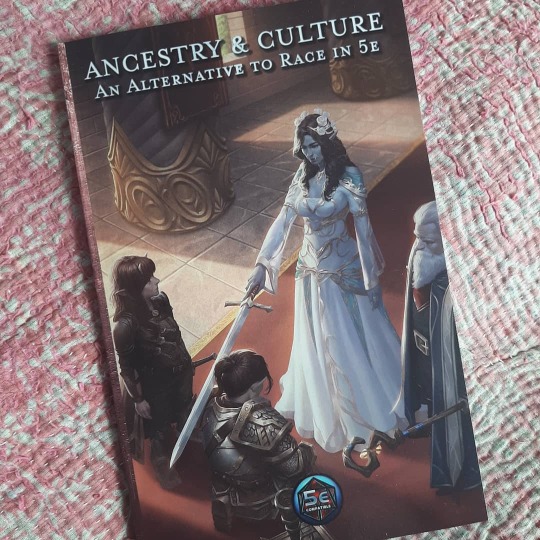
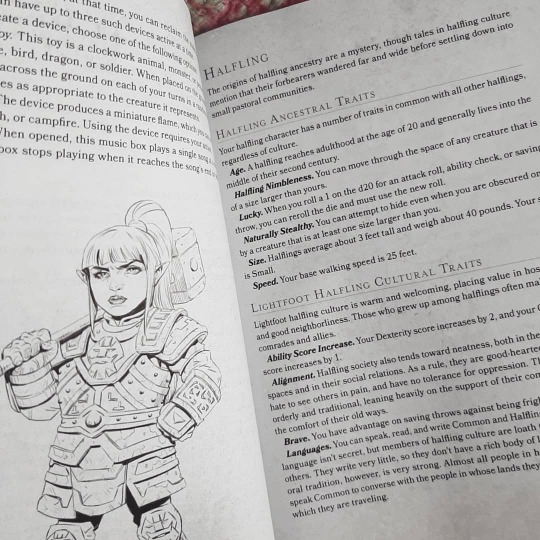
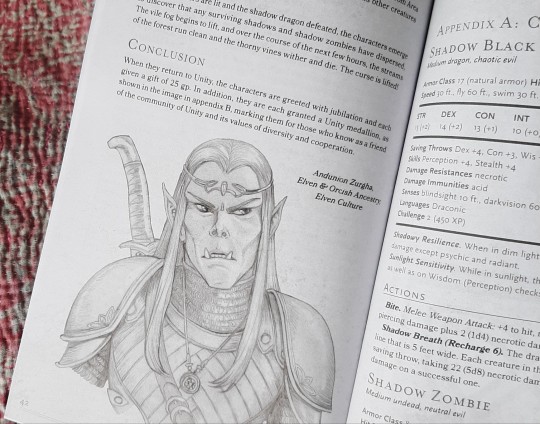
Ancestry & Culture: An alternative to Race in 5e
I just got my physical copy of this wonderful tome by Arcanist Press! It has a great introduction that explains why the use of the term “Race” in our beloved role-playing games is so problematic, and then offers a great solution for it that fits right in-between existing 5e rules.
We’ve been looking for a good alternative to “Race” for the character options we publish on our patreon, and we’re now going to do some tests to see if this model is something we could use.
I highly recommend you check it out! The free preview on DiveThruRPG includes the introduction & full rules for alternate character creation.
Find it here 👉 Ancestry & Culture
#how do you misunderstand star trek that badly#I constantly wonder#I should watch more Dr. Who#haven't seen nearly enough since I graduated college and left the Dr. Who club#but damn this person sounds like a DELIGHT#should I argue?no#but they mentioned star trek and off to the races I go#it is a pet peeve of mine#that people think star trek isn't progressive#like COME ON it was even progressive for its time!#and also John Boyega deserved better and I'm glad he's speaking out#I have not seen the star wars movies#but I like...know how to read so#long post#I'm so sorry y'all#I'm sleep deprived and hopped up on caffeine and love of star trek#and sci-fi in general#very long post#again#sorry#oh also feel free to ask for my main blog but obviously I don't want to do that on this post...
31K notes
·
View notes
Text
The problem with CN's current shows
For those who have been following me since the start of this year (or longer), you should know by now that I have quite a history with Cartoon Network. Back in January I wrote a journal saying that I was officially "done" with CN, and then in early August when CN started airing the original Teen Titans again, I stated why the original series should NOT be revived for a 6th season and how CN should stop relying on older properties and instead focus on new original content. Today, however, I'd like to discuss what I feel is the problem with Cartoon Network, being it's current crop of shows.
Now, I'd talk about how Teen Titans Go is being overplayed, but that horse has been beaten enough already. Recently though, based on a recent video by Vailskibum94 and a Skype discussion I had with @sesshaxiii the other day, I narrowed down what I believe is my problem with the network. I started by showing my friend a clip from Space Ghost Coast to Coast, and I said that Despite being one of the founding programs of Adult Swim, the original seasons were on CN during the evening hours (and was also the origin of the Adult Swim brand of humor). While I never watched the show during it's initial run (I wasn't even allowed to stay up past 8 PM back when I was 6 years old), this show was something I really like about early CN, being that it had something for everyone to enjoy, be they kids or adults, unlike the modern CN in which it plays things FAR too safe and makes everything super kid-friendly with no risks taken at all, because at least AS has respect for it's past programming while willing to try new things, all while CN has meddled itself into a corner by over-relying on one show and one genre, being slice-of-life comedy shows.
From it's founding in the early 90's to today, CN was always willing to experiment, it was always willing to try new things, and it had actual diversity. When CN first started, it was nothing but old Warner Bros and Hanna Barbera shows, and then it added original programming in the late 90's during what is collectively known as the "Powerhouse Era", considered by most to be the network's golden age. Back then, there was no real distinction between Cartoon Network and Adult Swim, no boundary between the two, and it wasn't uncommon to actually see advertisements for AS on daytime CN, which changed in 2005 when CN and Adult Swim split completely from each other, and the two have since become so separate and distinct from each other that it feels like the channel has a split-personality, with CN being the personality that tries to be "hip" and "trendy" and tries and looks cool in front of the kids, while AS is the more mature "adult" (no pun intended) half of the network that is willing to experiment and try new things.
To me, CN was never the same after 2008 when the original Toonami was discontinued. Now I could go on forever about the history of CN, as well as my personal accounts with it, but then we'd be here forever. And this brings me to what my problem with Cartoon Network is: Being that it has to do with what the current crop of programming on the network is, and I'm not simply talking about the overplaying of Teen Titans Go... it goes much further than that.
My problem with CN today is that almost every recent show the network has put out within the past 2-3 years (save for a few) lacks any real identity of it's own. Not only are three of the shows "reboots" (Teen Titans Go, Powerpuff Girls 2016, Ben 10 2016), but the fact that those three reboots and many of the other shows CN has put out like the Cloudy with a Chance of Meatballs series lack any identity of their own. Instead they basically steal the name of a pre-existing property and use it for monetary gain, since the new shows are so drastically different from the originals that people end up hating them because the reboots end up being a completely different genre.
But you're probably saying "Well, what if you change the name of the show and replace all the pre-existing characters and settings with completely original characters and such?" Well... that leads to another problem entirely, because even if these shows weren't in-name-only reboots of the original show, they really wouldn't be much better than they are already. And the reason why is... well, they're all interchangeable with each other, they all feel like they're cut from the same cloth, they all feel... identical. One of the reasons Cartoon Network became so successful to begin with was not only how diverse the programming was in terms of content, but the fact that every show felt like it's own distinct identity. You'd never see a plotline from Dexter's Lab be used in Ed, Edd n' Eddy, or the same style of dark humor from Courage the Cowardly Dog be used in The Grim Adventures of Billy and Mandy. Each show was different, each show was distinct, and each show was it's own individual entity. This is the reason Adventure Time, Regular Show, Steven Universe and Gumball all became massively popular, because they established their own identity, to which the reboots.
Other than Gumball, We Bare Bears, and the recent OK KO: Let's Be Heroes, the newer shows just... they lack that same magic that made the older shows special, they lack the timeless charm that could make them watchable 10 years from their initial debut. You could literally use the exact same plotline from a Teen Titans Go episode in an episode of the Ben 10 reboot, and nobody would tell the difference. It also doesn't help that these plots have most likely been done by other cartoons in the past, usually much better. For instance, I've seen an episode of Teen Titans Go that actually stole a joke that was used in an episode of The Simpsons over 20 years ago, and that joke was done FAR BETTER in The Simpsons than it was in TTG.
And it's not getting much better. Even though OK KO had a stellar debut and decent exposure from the network, it's ratings have slowly been declining in it's debut month with less airings as well (going with CN's infamous scheduling habits), the upcoming shows I've seen just... they don't look interesting to me at all. Could they be good? Depends, but so far, they're just not giving me that same feel I got from their older shows. Call me nostalgic here, but CN is doing more harm to itself than good, and if anything, their controversial practices can actually cause the end of the network.
Will CN get better? Only time will tell, but I'd like to say it eventually will get better, it's just going to be a while, so for now, we'll have to endure these hard times the best we can.
2 notes
·
View notes